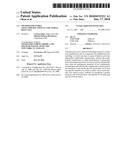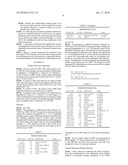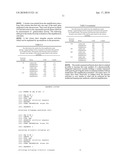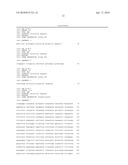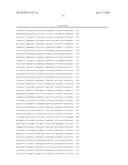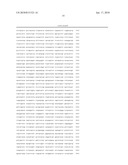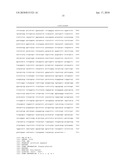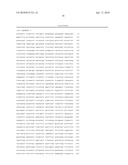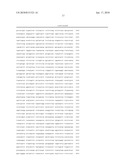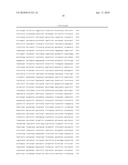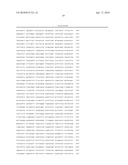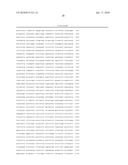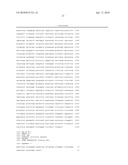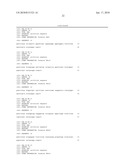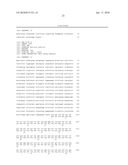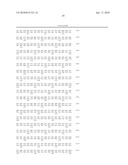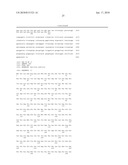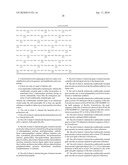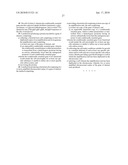Patent application title: Method for Stable Gene-Amplification in a Bacterial Host Cell
Inventors:
Carsten Olsen (Bagsvaerd, DK)
Michael Dolberg Rasmussen (Vallensbaek, DK)
Michael Dolberg Rasmussen (Vallensbaek, DK)
Assignees:
Novozymes A/S
IPC8 Class: AC12P2100FI
USPC Class:
435 691
Class name: Chemistry: molecular biology and microbiology micro-organism, tissue cell culture or enzyme using process to synthesize a desired chemical compound or composition recombinant dna technique included in method of making a protein or polypeptide
Publication date: 2010-06-17
Patent application number: 20100151521
Claims:
1. A bacterial host cell comprising at least two copies of an
amplification unit in its genome, said amplification unit comprising:i)
at least one copy of a gene of interest, andii) an expressible
conditionally essential gene, wherein the conditionally essential gene is
either promoterless or transcribed from a heterologous promoter having an
activity substantially lower than the endogenous promoter of said
conditionally essential gene, andwherein the conditionally essential gene
if not functional would render the cell auxotrophic for at least one
specific substance or unable to utilize one or more specific sole carbon
source.
2. The cell of claim 1, wherein the bacterial cell is a prokaryotic cell.
3. The cell of claim 2, wherein the bacterial prokaryotic cell is a Gram-positive cell.
4. The cell of claim 3, wherein the bacterial Gram positive cell is a species of the genus Bacillus.
5. The cell of claim 1, wherein the gene of interest encodes an enzyme with an activity selected from the group consisting of aminopeptidase, amylase, amyloglucosidase, carbohydrase, carboxypeptidase, catalase, cellulase, chitinase, cutinase, cyclodextrin glycosyltransferase, deoxyribonuclease, esterase, galactosidase, beta-galactosidase, glucoamylase, glucose oxidase, glucosidase, haloperoxidase, hemicellulase, invertase, isomerase, laccase, ligase, lipase, lyase, mannosidase, oxidase, pectinase, peroxidase, phytase, phenoloxidase, polyphenoloxidase, protease, ribonuclease, transferase, transglutaminase, or xylanase.
6. The cell of claim 1, wherein the gene of interest encodes an antimicrobial peptide.
7. The cell of claim 1, wherein the gene of interest encodes a peptide with biological activity in the human body.
8. The cell of claim 1, wherein the conditionally essential gene encodes an enzyme from the biosynthetic pathway of an amino acid.
9. The cell of claim 8, wherein the conditionally essential gene encodes one or more polypeptide(s) involved in lysine, leucine or methionine synthesis.
10. The cell of claim 8, wherein the conditionally essential gene is at least 75% identical to the lysA sequence of Bacillus licheniformis shown in SEQ ID NO:48 of WO 02/00907 A1, the leuB sequence of Bacillus licheniformis, the metC sequence of Bacillus licheniformis shown in SEQ ID NO:42 of WO 02/00907 A1, or the metE sequence of Bacillus subtilis shown in positions 997 to 2199 of SEQ ID NO:16.
11. The cell of claim 1, wherein the conditionally essential gene encodes a glutamyl-tRNA reductase.
12. The cell of claim 1, wherein the conditionally essential gene is at least 75% identical to the hemA sequence of Bacillus licheniformis.
13. The cell of claim 1, wherein the conditionally essential gene encodes an enzyme required for xylose utilization.
14. The cell of claim 1, wherein the conditionally essential gene encodes a xylose isomerase and is at least 75% identical to the xylA gene of Bacillus licheniformis.
15. The cell of claim 1, wherein the conditionally essential gene encodes an enzyme required for gluconate utilization.
16. The cell of claim 1, wherein the conditionally essential gene encodes a gluconate kinase (EC 2.7.1.12) or a gluconate permease or both and is at least 75% identical to any of the gntK and gntP sequences of Bacillus licheniformis.
17. The cell of claim 1, wherein the conditionally essential gene encodes an enzyme required for glycerol utilization.
18. The cell of claim 1, wherein the conditionally essential gene encodes a glycerol uptake facilitator (permease), a glycerol kinase, or a glycerol dehydrogenase, and is at least 75% identical to any of the glpP, glpF, glpK, and glpD sequences of Bacillus licheniformis.
19. A method for producing a protein encoded by a gene of interest, comprisinga) culturing a bacterial host cell comprising at least two duplicated copies of an amplification unit in its genome, the amplification unit comprising:i) at least one copy of the gene of interest, andii) an expressible conditionally essential gene, wherein the conditionally essential gene is either promoterless or transcribed from a heterologous promoter having an activity substantially lower than the endogenous promoter of said conditionally essential gene,wherein the conditionally essential gene if not functional would render the cell auxotrophic for at least one specific substance or unable to utilize one or more specific sole carbon source; andb) recovering the protein.
20. A method for producing a bacterial cell comprising two or more amplified chromosomal copies of a gene of interest, the method comprising:a) providing a bacterial cell comprising at least one copy of an amplification unit, the unit comprising:i) at least one copy of the gene of interest, andii) an expressible functional copy of a conditionally essential gene, which is either promoterless or transcribed from a heterologous promoter having an activity substantially lower than the endogenous promoter of said conditionally essential gene,wherein the conditionally essential gene if not functional would render the cell auxotrophic for at least one specific substance or unable to utilize one or more specific sole carbon source;b) cultivating the cell under conditions suitable for growth in a medium deficient of said at least one specific substance and/or with said one or more specific sole carbon source, thereby providing a growth advantage to a cell in which the amplification unit has been duplicated in the chromosome; andc) selecting a cell wherein the amplification unit has been duplicated in the chromosome, whereby two or more amplified chromosomal copies of the gene of interest were produced.
Description:
CROSS-REFERENCE TO RELATED APPLICATIONS
[0001]This application is a continuation of U.S. application Ser. No. 10/575,697 filed Apr. 12, 2006 (now allowed) which is a 35 U.S.C. 371 national phase application of PCT/DK2004/000750 filed Oct. 29, 2004, which claims priority or the benefit under 35 U.S.C. 119 of Danish application no. PA 2003 01624 filed Oct. 31, 2003, and U.S. provisional application No. 60/518,916 filed Nov. 10, 2003, the contents of which are fully incorporated herein by reference.
FIELD OF INVENTION
[0002]In the biotech industry it is desirable to construct polypeptide production strains having several copies of a gene of interest stably chromosomally integrated, without leaving antibiotic resistance marker genes in the strains.
[0003]This invention relates to bacterial host cells comprising at least two copies of an amplification unit in its genome, said amplification unit comprising: i) at least one copy of a gene of interest, and ii) an expressible conditionally essential gene, wherein the conditionally essential gene is either promoterless or transcribed from a heterologous promoter having an activity substantially lower than the endogenous promoter of said conditionally essential gene, and wherein the conditionally essential gene if not functional would render the cell auxotrophic for at least one specific substance or unable to utilize one or more specific sole carbon source; methods for producing a protein using the cell of the invention, and methods for constructing the cell of the invention.
BACKGROUND OF THE INVENTION
[0004]In the industrial production of polypeptides it is of interest to achieve a product yield as high as possible. One way to increase the yield is to increase the copy number of a gene encoding a polypeptide of interest. This can be done by placing the gene on a high copy number plasmid, however plasmids are unstable and are often lost from the host cells if there is no selective pressure during the cultivation of the host cells. Another way to increase the copy number of the gene of interest is to integrate it into the host cell chromosome in multiple copies.
[0005]The present day public debate concerning the industrial use of recombinant DNA technology has raised some questions and concerns about the use of antibiotic resistance marker genes. Antibiotic marker genes are traditionally used as a means to select for strains carrying multiple copies of both the marker genes and an accompanying expression cassette coding for a polypeptide of industrial interest. In order to comply with the current demand for recombinant production host strains devoid of antibiotic markers, we have looked for possible alternatives to the present technology that will allow substitution of the antibiotic markers we use today with non-antibiotic marker genes.
[0006]WO 02/00907 (Novozymes, Denmark) discloses a method for stable chromosomal multi-copy integration of genes into a production host cell in specific well-defined sites. It is disclosed to first render a recipient cell deficient by inactivating one or more conditionally essential gene, e.g., to make the cell auxotrophic for an amino acid. A gene of interest may then be integrated into the chromosome along with a DNA sequence which complements the deficiency of the cell, thus making the resulting cell selectable; the Bacillus licheniformis metC gene is disclosed as a conditionally essential marker herein.
[0007]WO 01/90393 (Novozymes, Denmark) discloses a method for increasing the gene copy number in a host cell by gene-amplification, without leaving antibiotic resistance markers behind in the host cell. The disclosed method relies on rendering a specific type of conditionally essential chromosomal gene of the host cell non-functional. A single amplification unit comprising the gene of interest, and a DNA sequence, which when integrated into the chromosome complements the non-functional conditional essential chromosomal gene, is integrated into the chromosome.
[0008]In order to provide recombinant production strains devoid of antibiotic resistance markers, it remains of industrial interest to find new methods to stably integrate genes in multiple copies into host cell chromosomes. Even incremental improvements of existing methods or mere alternatives are of considerable interest to the industry.
SUMMARY OF THE INVENTION
[0009]The problem to be solved by the present invention is to provide alternative host cells comprising multiple copies of a gene of interest, which cells are devoid of antibiotic markers, for use in the industrial production of polypeptides in high yields.
[0010]The solution is based on the observation that an amplification unit can be integrated into the chromosome of a host cell, and subsequently be amplified, without the use of classical antibiotic markers, antibiotics, or endogenously produced inhibitory compounds.
[0011]In traditional amplification protocols, higher gene expression is a result of duplications of the antibiotic resistance marker gene, duplications which are selected in stepwise cultivation and selection rounds by adding increasing amounts of the antibiotic compound to the cultivation medium in each cultivation step.
[0012]A cell which has become auxotrophic, e.g., due to a non-functional conditionally essential gene, would normally be complemented back to the prototrophic phenotype by the integration (or restoration) in the chromosome of even one single functional copy of the non-functional gene. Since normally only one copy is needed, such genes have not previously been attractive candidates for amplification purposes.
[0013]However, the present inventors lowered the expression-level of a non-antibiotic conditionally essential gene by decreasing the promoter activity, so that more than one functional copy of the gene would be advantageous to a deficient host cell. The integration of an amplification unit comprising such a low-level expression conditionally essential gene, into a host cell deficient for the same gene, reproducibly resulted in genomic duplications of the integrated amplification unit, comparable to what has been observed when using traditional amplifiable antibiotic markers.
[0014]In fact, this invention provides the means for controlling the level of gene expression, i.e., copy-number, in a host cell. By choosing carefully the strength of the heterologous promoter expressing the conditionally essential marker gene in the amplification unit, the optimal copy-number of the amplification unit can be adjusted up or down, depending on the desired expression level of the gene of interest also comprised in the unit.
[0015]Accordingly, in a first aspect the invention relates to a bacterial host cell comprising at least two copies of an amplification unit in its genome, said amplification unit comprising: [0016]i) at least one copy of a gene of interest, and [0017]ii) an expressible conditionally essential gene, wherein the conditionally essential gene is either promoterless or transcribed from a heterologous promoter having an activity substantially lower than the endogenous promoter of said conditionally essential gene, andwherein the conditionally essential gene if not functional would render the cell auxotrophic for at least one specific substance or unable to utilize one or more specific sole carbon source.
[0018]In a second aspect, the invention relates to a method for producing a protein encoded by a gene of interest, comprising [0019]a) culturing a bacterial host cell comprising at least two duplicated copies of an amplification unit in its genome, the amplification unit comprising: [0020]i) at least one copy of the gene of interest, and [0021]ii) an expressible conditionally essential gene, wherein the conditionally essential gene is either promoterless or transcribed from a heterologous promoter having an activity substantially lower than the endogenous promoter of said conditionally essential gene, [0022]wherein the conditionally essential gene if not functional would render the cell auxotrophic for at least one specific substance or unable to utilize one or more specific sole carbon source; and [0023]b) recovering the protein.
[0024]In a final aspect, the invention also relates to a method for producing a bacterial cell comprising two or more amplified chromosomal copies of a gene of interest, the method comprising: [0025]a) providing a bacterial cell comprising at least one copy of an amplification unit, the unit comprising: [0026]i) at least one copy of the gene of interest, and [0027]ii) an expressible functional copy of a conditionally essential gene, which is either promoterless or transcribed from a heterologous promoter having an activity substantially lower than the endogenous promoter of said conditionally essential gene, [0028]wherein the conditionally essential gene if not functional would render the cell auxotrophic for at least one specific substance or unable to utilize one or more specific sole carbon source; [0029]b) cultivating the cell under conditions suitable for growth in a medium deficient of said at least one specific substance and/or with said one or more specific sole carbon source, thereby providing a growth advantage to a cell in which the amplification unit has been duplicated in the chromosome; and [0030]c) selecting a cell wherein the amplification unit has been duplicated in the chromosome, whereby two or more amplified chromosomal copies of the gene of interest were produced.
[0031]It is envisioned that all the preferred embodiments of the cell of the invention that are shown herein would be suitable for use in the methods of the second and third aspects of the invention
DEFINITIONS
[0032]In accordance with the present invention there may be employed conventional molecular biology, microbiology, and recombinant DNA techniques within the skill of the art. Such techniques are explained fully in the literature. See, e.g., Sambrook, Fritsch & Maniatis, Molecular Cloning: A Laboratory Manual, Second Edition (1989) Cold Spring Harbor Laboratory Press, Cold Spring Harbor, N.Y. (herein "Sambrook et al., 1989") DNA Cloning: A Practical Approach, Volumes I and II/D. N. Glover ed. 1985); Oligonucleotide Synthesis (M. J. Gait ed. 1984); Nucleic Acid Hybridization (B. D. Hames & S. J. Higgins eds (1985)); Transcription And Translation (B. D. Hames & S. J. Higgins, eds. (1984)); Animal Cell Culture (R. I. Freshney, ed. (1986)); Immobilized Cells And Enzymes (IRL Press, (1986)); B. Perbal, A Practical Guide To Molecular Cloning (1984).
[0033]A "polynucleotide" is a single- or double-stranded polymer of deoxyribonucleotide or ribonucleotide bases read from the 5' to the 3' end. Polynucleotides include RNA and DNA, and may be isolated from natural sources, synthesized in vitro, or prepared from a combination of natural and synthetic molecules.
[0034]A "nucleic acid molecule" or "nucleotide sequence" refers to the phosphate ester polymeric form of ribonucleosides (adenosine, guanosine, uridine or cytidine; "RNA molecules") or deoxyribonucleosides (deoxyadenosine, deoxyguanosine, deoxythymidine, or deoxycytidine; "DNA molecules") in either single stranded form, or a double-stranded helix. Double stranded DNA-DNA, DNA-RNA and RNA-RNA helices are possible. The term nucleic acid molecule, and in particular DNA or RNA molecule, refers only to the primary and secondary structure of the molecule, and does not limit it to any particular tertiary or quaternary forms. Thus, this term includes double-stranded DNA found, inter alia, in linear or circular DNA molecules (e.g., restriction fragments), plasmids, and chromosomes. In discussing the structure of particular double-stranded DNA molecules, sequences may be described herein according to the normal convention of giving only the sequence in the 5' to 3' direction along the nontranscribed strand of DNA (i.e., the strand having a sequence homologous to the mRNA). A "recombinant DNA molecule" is a DNA molecule that has undergone a molecular biological manipulation.
[0035]A nucleic acid molecule is "hybridizable" to another nucleic acid molecule, such as a cDNA, genomic DNA, or RNA, when a single stranded form of the nucleic acid molecule can anneal to the other nucleic acid molecule under the appropriate conditions of temperature and solution ionic strength (see Sambrook et al., supra). The conditions of temperature and ionic strength determine the "stringency" of the hybridization.
[0036]A DNA "coding sequence" or an "open reading frame (ORF)" is a double-stranded DNA sequence which is transcribed and translated into a polypeptide in a cell in vitro or in vivo when placed under the control of appropriate regulatory sequences. The boundaries of the coding sequence are determined by a start codon at the 5' (amino) terminus and a translation stop codon at the 3' (carboxyl) terminus. A coding sequence can include, but is not limited to, prokaryotic sequences, cDNA from eukaryotic mRNA, genomic DNA sequences from eukaryotic (e.g., mammalian) DNA, and even synthetic DNA sequences. If the coding sequence is intended for expression in a eukaryotic cell, a polyadenylation signal and transcription termination sequence will usually be located 3' to the coding sequence.
[0037]An expression vector is a DNA molecule, linear or circular, that comprises a segment encoding a polypeptide of interest operably linked to additional segments that provide for its transcription. Such additional segments may include promoter and terminator sequences, and optionally one or more origins of replication, one or more selectable markers, an enhancer, a polyadenylation signal, and the like. Expression vectors are generally derived from plasmid or viral DNA, or may contain elements of both.
[0038]Transcriptional and translational control sequences are DNA regulatory sequences, such as promoters, enhancers, terminators, and the like, that provide for the expression of a coding sequence in a host cell. In eukaryotic cells, polyadenylation signals are control sequences.
[0039]A "secretory signal sequence" is a DNA sequence that encodes a polypeptide (a "secretory peptide" that, as a component of a larger polypeptide, directs the larger polypeptide through a secretory pathway of a cell in which it is synthesized. The larger polypeptide is commonly cleaved to remove the secretory peptide during transit through the secretory pathway.
[0040]The term "promoter" is used herein for its art-recognized meaning to denote a portion of a gene containing DNA sequences that provide for the binding of RNA polymerase and initiation of transcription. Promoter sequences are commonly, but not always, found in the 5' non-coding regions of genes.
[0041]A chromosomal gene is rendered non-functional if the polypeptide that the gene encodes can no longer be expressed in a functional form. Such non-functionality of a gene can be induced by a wide variety of genetic manipulations as known in the art, some of which are described in Sambrook et al. vide supra. Partial deletions within the ORF of a gene will often render the gene non-functional, as will mutations.
[0042]The term "an expressible copy of a chromosomal gene" is used herein as meaning a copy of the ORF of a chromosomal gene, wherein the ORF can be expressed to produce a fully functional gene product. The expressible copy may not be transcribed from the native promoter of the chromosomal gene, it may instead be transcribed from a foreign or heterologous promoter, or it may indeed be promoterless and expressed only by transcriptional read-through from a gene present upstream of the 5' end of the ORF. Transcriptional read-through is intended to have the same meaning here as the generally recognized meaning in the art.
[0043]"Operably linked", when referring to DNA segments, indicates that the segments are arranged so that they function in concert for their intended purposes, e.g. transcription initiates in the promoter and proceeds through the coding segment to the terminator.
[0044]A coding sequence is "under the control" of transcriptional and translational control sequences in a cell when RNA polymerase transcribes the coding sequence into mRNA, which is then trans-RNA spliced and translated into the protein encoded by the coding sequence.
[0045]"Heterologous" DNA refers to DNA not naturally located in the cell, or in a chromosomal site of the cell. Preferably, the heterologous DNA includes a gene foreign to the cell.
[0046]As used herein the term "nucleic acid construct" is intended to indicate any nucleic acid molecule of cDNA, genomic DNA, synthetic DNA or RNA origin. The term "construct" is intended to indicate a nucleic acid segment which may be single- or double-stranded, and which may be based on a complete or partial naturally occurring nucleotide sequence encoding a polypeptide of interest. The construct may optionally contain other nucleic acid segments.
[0047]The nucleic acid construct of the invention encoding the polypeptide of the invention may suitably be of genomic or cDNA origin, for instance obtained by preparing a genomic or cDNA library and screening for DNA sequences coding for all or part of the polypeptide by hybridization using synthetic oligonucleotide probes in accordance with standard techniques (cf. Sambrook et al., supra).
[0048]The nucleic acid construct of the invention encoding the polypeptide may also be prepared synthetically by established standard methods, e.g. the phosphoamidite method described by Beaucage and Caruthers, Tetrahedron Letters 22 (1981), 1859-1869, or the method described by Matthes et al., EMBO Journal 3 (1984), 801-805. According to the phosphoamidite method, oligonucleotides are synthesized, e.g. in an automatic DNA synthesizer, purified, annealed, ligated and cloned in suitable vectors.
[0049]Furthermore, the nucleic acid construct may be of mixed synthetic and genomic, mixed synthetic and cDNA or mixed genomic and cDNA origin prepared by ligating fragments of synthetic, genomic or cDNA origin (as appropriate), the fragments corresponding to various parts of the entire nucleic acid construct, in accordance with standard techniques. The nucleic acid construct may also be prepared by polymerase chain reaction using specific primers, for instance as described in U.S. Pat. No. 4,683,202 or Saiki et al., Science 239 (1988), 487-491.
[0050]The term nucleic acid construct may be synonymous with the term "expression cassette" when the nucleic acid construct contains the control sequences necessary for expression of a coding sequence of the present invention
[0051]The term "control sequences" is defined herein to include all components which are necessary or advantageous for expression of the coding sequence of the nucleic acid sequence. Each control sequence may be native or foreign to the nucleic acid sequence encoding the polypeptide. Such control sequences include, but are not limited to, a leader, a polyadenylation sequence, a propeptide sequence, a promoter, a signal sequence, and a transcription terminator. At a minimum, the control sequences include a promoter, and transcriptional and translational stop signals. The control sequences may be provided with linkers for the purpose of introducing specific restriction sites facilitating ligation of the control sequences with the coding region of the nucleic acid sequence encoding a polypeptide.
[0052]The control sequence may be an appropriate promoter sequence, a nucleic acid sequence which is recognized by a host cell for expression of the nucleic acid sequence. The promoter sequence contains transcription and translation control sequences which mediate the expression of the polypeptide. The promoter may be any nucleic acid sequence which shows transcriptional activity in the host cell of choice and may be obtained from genes encoding extracellular or intracellular polypeptides either homologous or heterologous to the host cell.
[0053]The control sequence may also be a suitable transcription terminator sequence, a sequence recognized by a host cell to terminate transcription. The terminator sequence is operably linked to the 3' terminus of the nucleic acid sequence encoding the polypeptide. Any terminator which is functional in the host cell of choice may be used in the present invention.
[0054]The control sequence may also be a polyadenylation sequence, a sequence which is operably linked to the 3' terminus of the nucleic acid sequence and which, when transcribed, is recognized by the host cell as a signal to add polyadenosine residues to transcribed mRNA. Any polyadenylation sequence which is functional in the host cell of choice may be used in the present invention.
[0055]The control sequence may also be a signal peptide coding region, which codes for an amino acid sequence linked to the amino terminus of the polypeptide which can direct the expressed polypeptide into the cell's secretory pathway of the host cell. The 5' end of the coding sequence of the nucleic acid sequence may inherently contain a signal peptide coding region naturally linked in translation reading frame with the segment of the coding region which encodes the secreted polypeptide. Alternatively, the 5' end of the coding sequence may contain a signal peptide coding region which is foreign to that portion of the coding sequence which encodes the secreted polypeptide. A foreign signal peptide coding region may be required where the coding sequence does not normally contain a signal peptide coding region. Alternatively, the foreign signal peptide coding region may simply replace the natural signal peptide coding region in order to obtain enhanced secretion of the enzyme relative to the natural signal peptide coding region normally associated with the coding sequence. The signal peptide coding region may be obtained from a glucoamylase or an amylase gene from an Aspergillus species, a lipase or proteinase gene from a Rhizomucor species, the gene for the alpha-factor from Saccharomyces cerevisiae, an amylase or a protease gene from a Bacillus species, or the calf preprochymosin gene. However, any signal peptide coding region capable of directing the expressed polypeptide into the secretory pathway of a host cell of choice may be used in the present invention.
[0056]The control sequence may also be a propeptide coding region, which codes for an amino acid sequence positioned at the amino terminus of a polypeptide. The resultant polypeptide is known as a proenzyme or propolypeptide (or a zymogen in some cases). A propolypeptide is generally inactive and can be converted to mature active polypeptide by catalytic or autocatalytic cleavage of the propeptide from the propolypeptide. The propeptide coding region may be obtained from the Bacillus subtilis alkaline protease gene (aprE), the Bacillus subtilis neutral protease gene (nprT), the Saccharomyces cerevisiae alpha-factor gene, or the Myceliophthora thermophilum laccase gene (WO 95/33836).
[0057]It may also be desirable to add regulatory sequences which allow the regulation of the expression of the polypeptide relative to the growth of the host cell. Examples of regulatory systems are those which cause the expression of the gene to be turned on or off in response to a chemical or physical stimulus, including the presence of a regulatory compound. Regulatory systems in prokaryotic systems would include the lac, tac, and trp operator systems. In yeast, the ADH2 system or GAL1 system may be used. In filamentous fungi, the TAKA alpha-amylase promoter, Aspergillus niger glucoamylase promoter, and the Aspergillus oryzae glucoamylase promoter may be used as regulatory sequences. Other examples of regulatory sequences are those which allow for gene amplification. In eukaryotic systems, these include the dihydrofolate reductase gene which is amplified in the presence of methotrexate, and the metallothionein genes which are amplified with heavy metals. In these cases, the nucleic acid sequence encoding the polypeptide would be placed in tandem with the regulatory sequence.
[0058]Examples of suitable promoters for directing the transcription of the conditionally essential gene(s) of the present invention, especially in a bacterial host cell, are the promoters obtained from the E. coli lac operon, the Streptomyces coelicolor agarase gene (dagA), the Bacillus subtilis levansucrase gene (sacB), the Bacillus subtilis alkaline protease gene, the Bacillus licheniformis alpha-amylase gene (amyL), the Bacillus stearothermophilus maltogenic amylase gene (amyM), the Bacillus amyloliquefaciens alpha-amylase gene (amyQ), the Bacillus amyloliquefaciens BAN amylase gene, the Bacillus licheniformis penicillinase gene (penP), the Bacillus subtilis xylA and xylB genes, and the prokaryotic beta-lactamase gene (VIIIa-Kamaroff et al., 1978, Proceedings of the National Academy of Sciences USA 75:3727-3731), as well as the tac promoter (DeBoer et al., 1983, Proceedings of the National Academy of Sciences USA 80:21-25). Further promoters are described in "Useful proteins from recombinant bacteria" in Scientific American, 1980, 242:74-94; and in Sambrook et al., 1989, supra.
[0059]The term "auxotrophic" in the present context means that the auxotrophic cell requires at least one specific substance for growth and metabolism that the parental organism was able to synthesize on its own. The term is used with respect to organisms, such as strains of bacteria, that can no longer synthesize the substance(s) because of mutational changes.
[0060]An effective signal peptide coding region for bacterial host cells is the signal peptide coding region obtained from the maltogenic amylase gene from Bacillus NCIB 11837, the Bacillus stearothermophilus alpha-amylase gene, the Bacillus licheniformis subtilisin gene, the Bacillus licheniformis beta-lactamase gene, the Bacillus stearothermophilus neutral proteases genes (nprT, nprS, nprM), and the Bacillus subtilis PrsA gene. Further signal peptides are described by Simonen and Palva, 1993, Microbiological Reviews 57:109-137.
[0061]The present invention also relates to recombinant expression vectors comprising a nucleic acid sequence of the present invention, a promoter, and transcriptional and translational stop signals. The various nucleic acid and control sequences described above may be joined together to produce a recombinant expression vector which may include one or more convenient restriction sites to allow for insertion or substitution of the nucleic acid sequence encoding the polypeptide at such sites. Alternatively, the nucleic acid sequence of the present invention may be expressed by inserting the nucleic acid sequence or a nucleic acid construct comprising the sequence into an appropriate vector for expression. In creating the expression vector, the coding sequence is located in the vector so that the coding sequence is operably linked with the appropriate control sequences for expression, and possibly secretion.
[0062]The recombinant expression vector may be any vector (e.g., a plasmid or virus) which can be conveniently subjected to recombinant DNA procedures and can bring about the expression of the nucleic acid sequence. The choice of the vector will typically depend on the compatibility of the vector with the host cell into which the vector is to be introduced. The vectors may be linear or closed circular plasmids. The vector may be an autonomously replicating vector, i.e., a vector which exists as an extrachromosomal entity, the replication of which is independent of chromosomal replication, e.g., a plasmid, an extrachromosomal element, a minichromosome, or an artificial chromosome. The vector may contain any means for assuring self-replication. Alternatively, the vector may be one which, when introduced into the host cell, is integrated into the genome and replicated together with the chromosome(s) into which it has been integrated. The vector system may be a single vector or plasmid or two or more vectors or plasmids which together contain the total DNA to be introduced into the genome of the host cell, or a transposon.
[0063]The vectors of the present invention preferably contain one or more selectable markers which permit easy selection of transformed cells. A selectable marker is a gene the product of which provides for biocide or viral resistance, resistance to heavy metals, prototrophy to auxotrophs, and the like.
[0064]Antibiotic selectable markers confer antibiotic resistance to such antibiotics as ampicillin, kanamycin, chloramphenicol, tetracycline, neomycin, hygromycin or methotrexate. Suitable markers for yeast host cells are ADE2, HIS3, LEU2, LYS2, MET3, TRP1, and URA3.
[0065]The vectors of the present invention preferably contain an element(s) that permits stable integration of the vector, or of a smaller part of the vector, into the host cell genome or autonomous replication of the vector in the cell independent of the genome of the cell.
[0066]The vectors, or smaller parts of the vectors such as amplification units of the present invention, may be integrated into the host cell genome when introduced into a host cell. For chromosomal integration, the vector may rely on the nucleic acid sequence encoding the polypeptide or any other element of the vector for stable integration of the vector into the genome by homologous or nonhomologous recombination.
[0067]Alternatively, the vector may contain additional nucleic acid sequences for directing integration by homologous recombination into the genome of the host cell. The additional nucleic acid sequences enable the vector to be integrated into the host cell genome at a precise location(s) in the chromosome(s). To increase the likelihood of integration at a precise location, the integrational elements should preferably contain a sufficient number of nucleic acids, such as 100 to 1,500 base pairs, preferably 400 to 1,500 base pairs, and most preferably 800 to 1,500 base pairs, which are highly homologous with the corresponding target sequence to enhance the probability of homologous recombination. The integrational elements may be any sequence that is homologous with the target sequence in the genome of the host cell. Furthermore, the integrational elements may be non-encoding or encoding nucleic acid sequences; specific examples of encoding sequences suitable for site-specific integration by homologous recombination are given in WO 02/00907 (Novozymes, Denmark), which is hereby incorporated by reference in its totality.
[0068]On the other hand, the vector may be integrated into the genome of the host cell by non-homologous recombination. These nucleic acid sequences may be any sequence that is homologous with a target sequence in the genome of the host cell, and, furthermore, may be non-encoding or encoding sequences. The copy number of a vector, an expression cassette, an amplification unit, a gene or indeed any defined nucleotide sequence is the number of identical copies that are present in a host cell at any time. A gene or another defined chromosomal nucleotide sequence may be present in one, two, or more copies on the chromosome. An autonomously replicating vector may be present in one, or several hundred copies per host cell.
[0069]An amplification unit of the invention is a nucleotide sequence that can integrate into the chromosome of a host cell, whereupon it can increase in number of chromosomally integrated copies by duplication of multiplication. The unit comprises an expression cassette as defined herein comprising at least one copy of a gene of interest and an expressable copy of a chromosomal gene, as defined herein, of the host cell. When the amplification unit is integrated into the chromosome of a host cell, it is defined as that particular region of the chromosome which is prone to being duplicated by homologous recombination between two directly repeated regions of DNA. The precise border of the amplification unit with respect to the flanking DNA is thus defined functionally, since the duplication process may indeed duplicate parts of the DNA which was introduced into the chromosome as well as parts of the endogenous chromosome itself, depending on the exact site of recombination within the repeated regions. This principle is illustrated in Janniere et al. (1985, Stable gene amplification in the chromosome of Bacillus subtilis. Gene, 40: 47-55), which is incorporated herein by reference.
[0070]For autonomous replication, the vector may further comprise an origin of replication enabling the vector to replicate autonomously in the host cell in question. Examples of bacterial origins of replication are the origins of replication of plasmids pBR322, pUC19, pACYC177, pACYC184, pUB110, pE194, pTA1060, and pAMbeta1. Examples of origin of replications for use in a yeast host cell are the 2 micron origin of replication, the combination of CEN6 and ARS4, and the combination of CEN3 and ARS1. The origin of replication may be one having a mutation which makes its functioning temperature-sensitive in the host cell (see, e.g., Ehrlich, 1978, Proceedings of the National Academy of Sciences USA 75:1433).
[0071]The present invention also relates to recombinant host cells, comprising a nucleic acid sequence of the invention, which are advantageously used in the recombinant production of the polypeptides. The term "host cell" encompasses any progeny of a parent cell which is not identical to the parent cell due to mutations that occur during replication.
[0072]The cell is preferably transformed with a vector comprising a nucleic acid sequence of the invention followed by integration of the vector into the host chromosome. "Transformation" means introducing a vector comprising a nucleic acid sequence of the present invention into a host cell so that the vector is maintained as a chromosomal integrant or as a self-replicating extra-chromosomal vector. Integration is generally considered to be an advantage as the nucleic acid sequence is more likely to be stably maintained in the cell. Integration of the vector into the host chromosome may occur by homologous or non-homologous recombination as described above.
[0073]The transformation of a bacterial host cell may, for instance, be effected by protoplast transformation (see, e.g., Chang and Cohen, 1979, Molecular General Genetics 168:111-115), by using competent cells (see, e.g., Young and Spizizin, 1961, Journal of Bacteriology 81:823-829, or Dubnar and Davidoff-Abelson, 1971, Journal of Molecular Biology 56:209-221), by electroporation (see, e.g., Shigekawa and Dower, 1988, Biotechniques 6:742-751), or by conjugation (see, e.g., Koehler and Thorne, 1987, Journal of Bacteriology 169:5771-5278).
[0074]The transformed or transfected host cells described above are cultured in a suitable nutrient medium under conditions permitting the expression of the desired polypeptide, after which the resulting polypeptide is recovered from the cells, or the culture broth.
[0075]The medium used to culture the cells may be any conventional medium suitable for growing the host cells, such as minimal or complex media containing appropriate supplements. Suitable media are available from commercial suppliers or may be prepared according to published recipes (e.g. in catalogues of the American Type Culture Collection). The media are prepared using procedures known in the art (see, e.g., references for bacteria and yeast; Bennett, J. W. and LaSure, L., editors, More Gene Manipulations in Fungi, Academic Press, Calif., 1991).
[0076]If the polypeptide is secreted into the nutrient medium, the polypeptide can be recovered directly from the medium. If the polypeptide is not secreted, it is recovered from cell lysates. The polypeptide are recovered from the culture medium by conventional procedures including separating the host cells from the medium by centrifugation or filtration, precipitating the proteinaceous components of the supernatant or filtrate by means of a salt, e.g. ammonium sulphate, purification by a variety of chromatographic procedures, e.g. ion exchange chromatography, gelfiltration chromatography, affinity chromatography, or the like, dependent on the type of polypeptide in question.
[0077]The polypeptides may be detected using methods known in the art that are specific for the polypeptides. These detection methods may include use of specific antibodies, formation of an enzyme product, or disappearance of an enzyme substrate. For example, an enzyme assay may be used to determine the activity of the polypeptide.
[0078]The polypeptides of the present invention may be purified by a variety of procedures known in the art including, but not limited to, chromatography (e.g., ion exchange, affinity, hydrophobic, chromatofocusing, and size exclusion), electrophoretic procedures (e.g., preparative isoelectric focusing (IEF), differential solubility (e.g., ammonium sulfate precipitation), or extraction (see, e.g., Protein Purification, J.-C. Janson and Lars Ryden, editors, VCH Publishers, New York, 1989).
DETAILED DESCRIPTION OF THE INVENTION
[0079]The first aspect of the invention relates to a bacterial host cell comprising at least two copies of an amplification unit in its genome, said amplification unit comprising: [0080]i) at least one copy of a gene of interest, and [0081]ii) an expressible conditionally essential gene, wherein the conditionally essential gene is either promoterless or transcribed from a heterologous promoter having an activity substantially lower than the endogenous promoter of said conditionally essential gene, andwherein the conditionally essential gene if not functional would render the cell auxotrophic for at least one specific substance or unable to utilize one or more specific sole carbon source.
[0082]The choice of a host cell will to a large extent depend upon the gene encoding the polypeptide and its source. The host cell may be a unicellular microorganism, e.g., a prokaryote, or a non-unicellular microorganism, e.g., a eukaryote. Useful unicellular cells are bacterial cells such as gram positive bacteria including, but not limited to, a Bacillus cell, e.g., Bacillus alkalophilus, Bacillus amyloliquefaciens, Bacillus brevis, Bacillus circulans, Bacillus coagulans, Bacillus lautus, Bacillus lentus, Bacillus licheniformis, Bacillus megaterium, Bacillus stearothermophilus, Bacillus subtilis, and Bacillus thuringiensis; or a Streptomyces cell, e.g., Streptomyces lividans or Streptomyces murinus, or gram negative bacteria such as E. coli and Pseudomonas sp. In a preferred embodiment, the bacterial host cell is a Bacillus lentus, Bacillus licheniformis, Bacillus stearothermophilus or Bacillus subtilis cell. In one preferred embodiment, the bacterial host cell is a prokaryotic cell, preferably a Gram-positive prokaryotic cell, and more preferably the bacterial Gram positive cell is a species of the genus Bacillus, preferably selected from the group consisting of Bacillus alkalophilus, Bacillus amyloliquefaciens, Bacillus brevis, Bacillus circulans, Bacillus coagulans, Bacillus lautus, Bacillus lentus, Bacillus licheniformis, Bacillus megaterium, Bacillus stearothermophilus, Bacillus subtilis, and Bacillus thuringiensis.
[0083]As described above, chromosomal integration of a vector or a smaller part of a vector, such as an amplification unit of the invention, into the genome of the host cell can be achieved by a number of ways. A non-limiting example of integration by homologous recombination is shown herein.
[0084]A preferred embodiment of the invention relates to the cells of the invention, or the methods of the invention, wherein the amplification unit further comprises a nucleotide sequence with a homology to a chromosomal nucleotide sequence of the host cell sufficient to effect chromosomal integration in the host cell of the amplification unit by homologous recombination, preferably the amplification unit further comprises a nucleotide sequence of at least 100 bp, preferably 200 bp, more preferably 300 bp, even more preferably 400 bp, and most preferably at least 500 by with an identity of at least 70%, preferably 80%, more preferably 90%, even more preferably 95%, and most preferably at least 98% identity to a chromosomal nucleotide sequence of the host cell.
[0085]In a non-limiting example integration into the chromosome of a host cell can be selected for by first rendering a conditionally essential host cell gene non-functional as described elsewhere herein, thereby rendering the host cell selectable, then targetting the vector's integration by including on this a likewise non-functional copy of same host gene of a size that allows homologous recombination between the two different copies of the non-functional host genes in the genome of the host cell and on the integration vector, tailored so that such a recombination will restore a functional copy of the gene, thus leaving the host cell selectable. Or the vector may simply comprise a functional copy of the conditionally essential gene, to select for integration anywhere in the genome.
[0086]A preferred embodiment of the invention relates to the cell of the invention, wherein a first amplification unit integrates into the host cell chromosome by homologous recombination with the partially deleted conditionally essential gene and renders the gene functional.
[0087]A preferred embodiment of the invention relates to the cell of the invention, wherein the gene of interest encodes a polypeptide of interest, preferably the polypeptide is an enzyme such as a protease; a cellulase; a lipase; a xylanase; a phospholipase; or preferably an amylase.
[0088]Another preferred embodiment of the invention relates to the cell of the invention, wherein the polypeptide is a hormone, a pro-hormone, a pre-pro-hormone, a small peptide, a receptor, or a neuropeptide.
[0089]Still another preferred embodiment of the invention relates to the cell of the invention, wherein the gene of interest encodes an enzyme, preferably an amylolytic enzyme, a lipolytic enzyme, a proteolytic enzyme, a cellulytic enzyme, an oxidoreductase or a plant cell-wall degrading enzyme, and more preferably an enzyme with an activity selected from the group consisting of aminopeptidase, amylase, amyloglucosidase, carbohydrase, carboxypeptidase, catalase, cellulase, chitinase, cutinase, cyclodextrin glycosyltransferase, deoxyribonuclease, esterase, galactosidase, beta-galactosidase, glucoamylase, glucose oxidase, glucosidase, haloperoxidase, hemicellulase, invertase, isomerase, laccase, ligase, lipase, lyase, mannosidase, oxidase, pectinase, peroxidase, phytase, phenoloxidase, polyphenoloxidase, protease, ribonuclease, transferase, transglutaminase, or xylanase.
[0090]In a preferred embodiment, the invention relates to a cell, wherein the gene of interest encodes an antimicrobial peptide, preferably an anti-fungal peptide or an anti-bacterial peptide, or a peptide with biological activity in the human body, preferably a pharmaceutically active peptide, more preferably insulin/pro-insulin/pre-pro-insulin or variants thereof, growth hormone or variants thereof, or blood clotting factor VII or VIII or variants thereof.
[0091]Conditionally essential genes are well-characterized in the literature, for instance genes that are required for a cell to synthesize one or more amino acids, where a non-functional gene encoding a polypeptide required for synthesis of an amino acid renders the cell auxotrophic for that amino acid, and the cell can only grow if the amino acid is supplied to the growth medium. Restoration of the functionality of such a gene, or complementation by providing an exogenous functional copy of such a gene, allows the cell to synthesise the amino acid on its own, and it becomes selectable against a background of auxotrophic cells.
[0092]Consequently, a preferred embodiment of the invention relates to a cell of the first aspect, wherein the conditionally essential chromosomal gene(s) of the host cell encodes one or more polypeptide(s) involved in amino acid synthesis, and the non-functionality of the endogenous versions of the gene(s) renders the cell auxotrophic for one or more amino acid(s), and wherein restoration of the functionality of the gene(s) renders the cell prototrophic for the amino acid(s).
[0093]Bacillus subtilis metE encodes a S-adenosyl-methionine synthetase, the metE/MetE sequences are available from EMBL:BS52812 (accession no. U52812) (Yocum, R. R.; Perkins, J. B.; Howitt, C. L.; Pero, J.; 1996. Cloning and characterization of the metE gene encoding S-adenosylmethionine synthetase from Bacillus subtilis. J. Bacteriol. 178(15):4604).
[0094]The leuB gene encodes 3-isopropylmalate dehydrogenase, which catalyses the conversion of 3-carboxy-2-hydroxy-4-methylpentanoate to 3-carboxy-4-methyl-2-oxopentanoate. A leuB-deficient strain will be a leucine auxotroph.
[0095]The lysA gene encoding diaminopimelate decarboxylase, which catalyses the conversion of Meso-2,6-diaminoheptanedioate to L-lysine. A lysA-deficient strain will be a lysine auxotroph.
[0096]A preferred embodiment relates to a cell of the invention, wherein the conditionally essential gene encodes an enzyme from the biosynthetic pathway of an amino acid; preferably the conditionally essential gene encodes one or more polypeptide(s) involved in lysine, leucine or methionine synthesis, preferably the conditionally essential gene is homologous to the lysA, leuB, metC, or the metE gene from Bacillus subtilis, and more preferably the conditionally essential gene is the lysA, leuB, metC, or metE gene from Bacillus licheniformis; more preferably the conditionally essential gene is at least 75% identical, preferably 85% identical, more preferably 95% and most preferably at least 97% identical to the lysA sequence of Bacillus licheniformis shown in SEQ ID NO:48 of WO 02/00907 A1, the leuB sequence of Bacillus licheniformis, the metC sequence of Bacillus licheniformis shown in SEQ ID NO:42 of WO 02/00907 A1, or the metE sequence of Bacillus subtilis shown in positions 997 to 2199 of SEQ ID NO:16.
[0097]The hemA gene encodes glutamyl-tRNA reductase, which catalyses the synthesis of 5-amino leuvulinic acid. A hemA-deficient strain will have to be supplemented with 5-amino leuvulinic acid or haemin.
[0098]In another embodiment, the conditionally essential gene encodes a glutamyl-tRNA reductase, preferably the conditionally essential gene is homologous to the hemA gene from Bacillus subtilis, and more preferably the conditionally essential gene is the hemA gene from Bacillus licheniformis; preferably the conditionally essential gene is at least 75% identical, preferably 85% identical, more preferably 95% and most preferably at least 97% identical to the hemA sequence of Bacillus licheniformis.
[0099]The conditionally essential gene(s) may encode polypeptides involved in the utilization of specific carbon sources such as xylose, glucanate, glycerol, or arabinose, in which case the host cell is unable to grow in a minimal medium supplemented with only that specific carbon source when the gene(s) are non-functional.
[0100]A preferred embodiment of the invention relates to a cell of the invention, wherein the at least one conditionally essential chromosomal gene(s) is one or more genes that are required for the host cell to grow on minimal medium supplemented with only one specific main carbon-source.
[0101]A preferred embodiment relates to a cell of the invention, wherein the at least one conditionally essential gene encodes an enzyme required for xylose utilization, preferably the conditionally essential gene is homologous to the xylA gene from Bacillus subtilis, and more preferably the conditionally essential gene is homologous to a gene of the xylose isomerase operon of Bacillus licheniformis, most preferably to the xylA gene of Bacillus licheniformis; preferably the conditionally essential gene encodes a xylose isomerase and is at least 75% identical, preferably 85% identical, more preferably 95% and most preferably at least 97% identical to the xylA gene of Bacillus licheniformis.
[0102]Another preferred embodiment relates to a cell of the invention, wherein the at least one conditionally essential gene encodes an enzyme required for gluconate utilization, preferably the conditionally essential gene encodes a gluconate kinase (EC 2.7.1.12) or a gluconate permease, more preferably the gene is homologous to the gntK gene or the gntP gene from Bacillus subtilis, and most preferably the gene is the gntK or gntP gene from Bacillus licheniformis; preferably the conditionally essential gene encodes a gluconate kinase (EC 2.7.1.12) or a gluconate permease or both and is at least 75% identical, preferably 85% identical, more preferably 95% and most preferably at least 97% identical to any of the gntK and gntP sequences of Bacillus licheniformis.
[0103]Still another preferred embodiment relates to a cell of the invention, wherein the conditionally essential gene encodes an enzyme required for glycerol utilization, preferably the conditionally essential gene encodes a glycerol uptake facilitator (permease), a glycerol kinase, or a glycerol dehydrogenase, more preferably the conditionally essential gene is homologous to the glpP, glpF, glpK, or the glpD gene from Bacillus subtilis, and most preferably the conditionally essential gene comprises one or more of the glpP, glpF, glpK, and glpD genes from Bacillus licheniformis shown in SEQ ID NO:26 of published PCT application WO 02/00907 A1 (Novozymes A/S) which is incorporated herein by reference in its totality; preferably the conditionally essential gene encodes a glycerol uptake facilitator (permease), a glycerol kinase, or a glycerol dehydrogenase, and is at least 75% identical, preferably 85% identical, more preferably 95% and most preferably at least 97% identical to any of the glpP, glpF, glpK, and glpD sequences of Bacillus licheniformis shown in SEQ ID NO:26 of WO 02/00907 A1.
[0104]One more preferred embodiment relates to a cell of the invention, wherein the conditionally essential gene encodes an enzyme required for arabinose utilization, preferably an arabinose isomerase, more preferably the gene is homologous to the araA gene from Bacillus subtilis, and most preferably the gene is the araA gene from Bacillus licheniformis shown in SEQ ID NO:38 of WO 02/00907 A1; preferably the conditionally essential gene encodes an arabinose isomerase, and is at least 75% identical, preferably 85% identical, more preferably 95% and most preferably at least 97% identical to the araA sequence of Bacillus licheniformis shown in SEQ ID NO:38 of WO 02/00907 A1.
[0105]The amplification unit in the cell of the invention may also include an antibiotic marker gene. However, as it is preferred not to have marker genes in the chromosome, an alternative way of removing the marker gene must be employed. Specific restriction enzymes denoted resolvases excise portions of DNA if each portion is flanked on both sides by certain recognition sequences known as resolvase sites or res-sites; these resolvase enzymes are well-known in the art, see e.g. WO 96/23073 (Novo Nordisk A/S) which is included herein by reference.
[0106]A preferred embodiment relates to a cell of the invention, wherein the amplification unit further comprises an antibiotic selection marker, preferably the selection marker is flanked by resolvase sites or res-sites.
[0107]Subsequent to the action of the resolvase enzyme, the antibiotic restriction marker flanked by res-sites will have been excised from the chromosome of the cell, leaving only one copy of the res-site behind as testimony to the procedure.
[0108]Accordingly, a preferred embodiment relates to a cell of the invention, wherein the amplification unit further comprises a resolvase site or res-site.
[0109]As the present invention relies on a reduced transcription of the conditionally essential gene comprised in the amplification unit as compared to its wild-type transcription level, it may be an advantage to include one or more transcription terminators upstream of the gene in different reading frames, in order to avoid any unintentional read-through transcription from a gene further upstream in the chromosome from where the unit was integrated.
[0110]A preferred embodiment relates to a cell of the invention, wherein the conditionally essential gene comprised in the amplification unit has at least one transcription terminator located upstream of the gene.
[0111]Another way of reducing transcription of the conditionally essential gene is to express it from a heterologous or completely artificial promoter, which has a reduced activity as compared to the wild-type or endogenous promoter normally transcribing said gene. Preferably, the conditionally essential gene is transcribed from a heterologous promoter having an activity level, when compared with the endogenous promoter of the conditionally essential gene, which is reduced with a factor of 2, preferably 5, more preferably 10, even more preferably 50, and most preferably with a factor of 100.
[0112]Still another strategy could be to have a promoterless conditionally essential gene in the amplification unit, and then simply rely on what read-through transcription there might from any other gene(s) located upstream of the conditionally essential gene, before or after integration of the unit into the chromosome of the cell of the invention. Preferably, the conditionally essential gene is promoterless; and more preferably the gene of interest is located upstream of the conditionally essential gene in the amplification unit, so that the two genes are co-directionally transcribed, whereby the conditionally essential gene is expressed by read-through transcription from the gene of interest.
[0113]A second aspect of the invention relates to a method for producing a protein encoded by a gene of interest, comprising [0114]a) culturing a bacterial host cell comprising at least two duplicated copies of an amplification unit in its genome, the amplification unit comprising: [0115]i) at least one copy of the gene of interest, and [0116]ii) an expressible conditionally essential gene, wherein the conditionally essential gene is either promoterless or transcribed from a heterologous promoter having an activity substantially lower than the endogenous promoter of said conditionally essential gene, [0117]wherein the conditionally essential gene if not functional would render the cell auxotrophic for at least one specific substance or unable to utilize one or more specific sole carbon source; and [0118]b) recovering the protein.
[0119]As already mentioned, any cell of the invention is envisioned to be suitable in the methods of the second aspect, in particular the preferred embodiments outlined in the above.
[0120]A final aspect of the invention relates to methods for producing a bacterial cell comprising two or more amplified chromosomal copies of a gene of interest, the method comprising: [0121]a) providing a bacterial cell comprising at least one copy of an amplification unit, the unit comprising: [0122]i) at least one copy of the gene of interest, and [0123]ii) an expressible functional copy of a conditionally essential gene, which is either promoterless or transcribed from a heterologous promoter having an activity substantially lower than the endogenous promoter of said conditionally essential gene, [0124]wherein the conditionally essential gene if not functional would render the cell auxotrophic for at least one specific substance or unable to utilize one or more specific sole carbon source; [0125]b) cultivating the cell under conditions suitable for growth in a medium deficient of said at least one specific substance and/or with said one or more specific sole carbon source, thereby providing a growth advantage to a cell in which the amplification unit has been duplicated in the chromosome; and [0126]c) selecting a cell wherein the amplification unit has been duplicated in the chromosome, whereby two or more amplified chromosomal copies of the gene of interest were produced.
[0127]Again, as already mentioned, the methods of the final aspect of the invention are envisioned as being suitable for producing any cell of the invention, in particular the preferred embodiments of said cell that are outlined in the above.
EXAMPLES
Strains and Donor Organisms
[0128]Bacillus subtilis PL1801. This strain is the B. subtilis DN1885 with disrupted apr and npr genes (Diderichsen, B., Wedsted, U., Hedegaard, L., Jensen, B. R., Sjoholm, C. (1990) Cloning of aldB, which encodes alpha-acetolactate decarboxylase, an exoenzyme from Bacillus brevis. J. Bacteriol., 172, 4315-4321).
[0129]B. subtilis CL046. This strain is a B. subtilis PL1801 where the metE gene is deleted and replaced with the kanamycine (kan) resistance gene from pUB110 by use of the plasmid pCLO43.
[0130]B. subtilis CL049. This strain is the CL046 strain where the kanamycine resistance gene is deleted.
[0131]Competent cells were prepared and transformed as described by Yasbin, R. E., Wilson, G. A. and Young, F. E. (1975) Transformation and transfection in lysogenic strains of Bacillus subtilis: evidence for selective induction of prophage in competent cells. J. Bacteriol, 121:296-304.
Plasmids
[0132]pCLO43:
[0133]This plasmid is a pBR322 derivative (Watson, N., 1988 Gene 70(2):399-403) essentially containing elements making the plasmid propagatable in E. coli, a ampicillin resistance gene, a gene conferring resistance to kanamycine, two flanking fragments from B. subtilis metE inserted upstream and downstream of the kanamycine resistance gene, two direct repeats that signify the res site from pAMBeta1 (Janniere, L., 1996, Nucleic Acids Res. 24(17):3431-3436. This plasmid is used for deleting the metE gene in the B. subtilis strain PL1801.
TABLE-US-00001 TABLE 1 Plasmid pCLO43, 7311 bp Position (bp) Size (bp) Element (bp) Origin 1-973 973 Upstream metE seq. B. subtilis 974-1010 37 Linker Synthetic 10111-1184 174 res site from pAMbeta1 E. faecalis 1185-1190 6 Linker Synthetic 1191-2159 969 pUB110 (Kan gene) S. aureus 2160-2162 3 Linker Synthetic 2163-2336 174 res site from pAMβ1 E. faecalis 2337-2357 21 Linker Synthetic 2358-3870 1513 Downstream metE seq. B. subtilis 3871-7311 3441 pBR322 E. coli
pCLO1154
[0134]This plasmid is a pBR322 derivative (Watson, N., 1988 Gene 70(2):399-403) containing elements making the plasmid propagatable in E. coli. The plasmid codes for the ampicillin resistance gene, the kanamycine resistance gene, the chloramphenicol resistance gene and the lacZ gene from E. coli. The gfp gene from A. victoria and the metE gene from B. subtilis are transcriptionally fused in the plasmid controlled by a promoter that can be exchanged with other promoters. This plasmid is used for integration and amplification studies in the amyE locus of CL049. The primers for metE fragment PCR amplifications on chromosomal DNA isolated from PL1801 are as follows:
TABLE-US-00002 P52 (SEQ ID NO: 1): aataataaagatctggaggagaaacaatgacaacc P53 (SEQ ID NO: 2): aaataataagatctaaattatactagctgtgtc
TABLE-US-00003 TABLE 2 Plasmid pCLO1154, 13135 bp. Position (bp) Size (bp) Element (bp) Origin 1-539 539 Upstream amyE B. subtilis 540-2853 2314 metE gene B. subtilis 2854-2891 38 Linker Synthetic 2892-3605 714 gfp gene A. victoria 3606-3739 134 Promoter - alr B. subtilis 3740-3785 46 Linker Synthetic 3786-4821 1036 pC194 (cat gene) S. aureus 4822-5008 187 part of tetC gene E. coli 5009-5106 98 Promoter Synthetic 5107-5111 6 Linker Synthetic 5112-8224 3113 spoVG-lacZ fusion B. subtilis & E. coli 8226-8314 89 part of tetC gene E. coli 8315-9657 1343 Downstream amyE B. subtilis 9658-9845 188 Linker Synthetic 9846-11117 1272 pUB110 (neo gene) S. aureus 11118-11184 67 Linker Synthetic 11185-11277 93 Tn5 fragment E. coli 11278-11281 4 Linker Synthetic 11282-13119 1838 pBR322 (bla gene) E. coli 13120-13129 10 Linker Synthetic
Propagation of PL1801 Strain for LacZ Activity Determination
[0135]The B. subtilis strain PL1801 was propagated in liquid medium TY. After 10 generations of incubation at 37° C. and 300 rpm, the cells were harvested, and cells were disrupted by sonic or lysozyme treatment.
General Molecular Biology Methods
[0136]Unless otherwise mentioned the DNA manipulations and transformations were performed using standard methods of molecular biology (Sambrook et al. (1989) Molecular cloning: A laboratory manual, Cold Spring Harbor lab., Cold Spring Harbor, N.Y.; Ausubel, F. M. et al. (eds.) "Current protocols in Molecular Biology". John Wiley and Sons, 1995; Harwood, C. R., and Cutting, S. M. (eds.) "Molecular Biological Methods for Bacillus". John Wiley and Sons, 1990).
[0137]Enzymes for DNA manipulations were used according to the specifications of the suppliers (e.g. restriction endonucleases, ligases etc. are obtainable from New England Biolabs, Inc.).
Media
[0138]TY: (as described in Ausubel, F. M. et al. (eds.) "Current protocols in Molecular Biology". John Wiley and Sons, 1995). LB agar (as described in Ausubel, F. M. et al. (eds.) "Current protocols in Molecular Biology". John Wiley and Sons, 1995). Minimal TSS agar: As described in Fouet A. and Sonenshein, A. L. (1990) A Target for Carbon Source-Dependant Negative Regulation of the citB Promoter of Bacillus subtilis. J. Bacteriol., 172, 835-844. For plates, 2% agar was added and for methionine auxotropy determination the plates were supplemented with 50 microg/ml methionine.
[0139]Assay for Beta-Galactosidase Activity
[0140]Beta-galactosidase activity was determined by a method using ortho-nitrophenyl-beta-D-galactopyranoside as enzymatic substrate. Under a specified set of conditions (temp., pH, reaction time, buffer conditions) a given amount of beta-galactosidase will degrade a certain amount of substrate and a yellow colour will be produced. The colour intensity is measured at 420 nm. The measured absorbance is directly proportional to the activity of the beta-galactosidase in question under a given set of conditions.
Deletion of metE in B. subtilis
[0141]A plasmid Was constructed for the purpose of deleting the metE gene in B. subtilis. Two flanking sequences upstream and downstream of the galE gene were amplified by PCR and fused by PCR on each side of a kanamycine (Kana) marker. This fragment was ligated in plasmid pBR322.
TABLE-US-00004 Upstream metE fragment: P42 (SEQ ID NO: 3): attttataggatcccgctgattcattttcttctgcgaac P43 (SEQ ID NO: 4): gaattccatcgcactggacgacattttcaggtcgattctcggaaatcc Downstream metE fragment: P44 (SEQ ID NO: 5): cccgaggcctttcaggcccgcaaacaatatggttgaagccgcaaaacagg P45 (SEQ ID NO: 6): ataataatggtaccatattgatgtgacacttgaagttgc
[0142]The resulting plasmid pCLO43 (SEQ ID NO: 7) was linearised and transferred to B. subtilis PL1801 and plated on LBPG media with 10 μg/ml kanamycine, which left the Kan marker in place of the metE gene.
[0143]A metE deletion strain designated CL046 was tested on minimal media without mehionine. The original B. subtilis PL1801 (metE.sup.+) strain showed fine growth on these plates while the metE strain CL046 showed no growth even after several days of incubation. On control minimal plates supplemented with 50 μg/ml methionine, both strains grew. The reported auxotrophic phenotype on a metE strain is therefore confirmed.
[0144]The Kan marker located in the metE locus of CL046 was flanked by resolvase recognition sites (res), which allow a specific excision reaction in the presence of a resolvase. In order to remove the Kan marker from the chromosome, CL046 was transformed with pWT, which is a temperature sensitive plasmid that comprises a gene coding for resolvase and an erythromycine (Erm) resistance marker. Transformants were selected on plates with 5 microg/ml Erm. They were tested for loss of the Kan marker and further re-streaked twice on plates with no antibiotics at 50° C. to cure the strains of the pWT plasmid. Selected clones were screened for loss of Erm resistance and Kan resistance and were designated CL049 (PL1801, metE.sup.-; no antibiotic markers).
Amplification Plasmids
[0145]An amplification plasmid was made having a transcriptional unit consisting of the gfp gene and the metE gene with a cloning site in front of the two genes, wherein a promoter could be cloned (pCLO1154, SEQ ID NO: 8). The lacZ reporter gene was also present on the plasmid expressed from a promoter separate from the promoter in front of the metE gene. Flanking these two transcriptional units was fragments from the amyE locus in B. subtilis.
[0146]Promoters with varying promoter activity were cloned in front of the gfp-metE transcriptional unit in the EcoRI and HindIII sites. The promoter activities spanned from 30 to 519 arbitrary units. See table 3.
TABLE-US-00005 TABLE 3 The table shows the promoters used in the amplification experiment and the sequence is given. Promoter Activity/Units Sequence Pr30 30 (SEQ ID NO: 9) Pr43 43 (SEQ ID NO: 10) Pr119 119 (SEQ ID NO: 11) Pr164 164 (SEQ ID NO: 12) Pr342 342 (SEQ ID NO: 13) Pr409 409 (SEQ ID NO: 14) Pr519 519 (SEQ ID NO: 15)
Amplification Experiments
[0147]The resulting amplification plasmids were introduced by transformation into CLO49 (metE) and plated on solid LB media supplemented with 6 microg/ml chloramphenicol. Transformants were screened for resistance to kanamycine.
[0148]Transformants being sensitive to kanamycine would have integrated part of the amplification plasmid at the amyE locus including the lacZ reporter gene and the gfp-metE operon. Those transformans would have only one copy of the genes present and they cannot be amplified.
[0149]Transformants being resistant to kanamycine would have the whole amplification plasmid integrated at the amyE locus and amplification would be possible.
[0150]Both types of transformants were plated on solid minimal TSS media without methionine. Several colonies were obtained from the transformants having the whole plasmid integrated at the amyE locus, whereas the transformants that had only part of the plasmid integrated showed no growth on minimal medium. This indicated that even with the strongest promoter, one copy of the metE gene did not express sufficient MetE protein to complement the methionine auxotrophy of the strain. However, amplification of the metE gene did result in growth of the strain.
[0151]Colonies were picked from the amplification step a long with colonies that had only one copy of the metE gene integrated in the chromosome. They were all grown in liquid LB and harvested in the exponential growth phase followed by measurement of--galactosidase activity. The following table gives the results from the evaluation of the amplification outcomes.
[0152]A few clones show irregular enzyme activities, which can be explained by up-mutations in the promoters.
TABLE-US-00006 TABLE 4 The table shows the results from the amplification trials and the quadrature-galactosidase activity measured in all strains after growth in LB lipuid media. The enzyme activities have been converted to the gene copy number of the reporter gene based on the enzyme activities. Promoter Strength Strain Units Copies 30 1 gene copy 105 1.0 Amplification 1361 12.4 Amplification 218 2.0 43 1 gene copy 101 0.9 Amplification 1467 13.4 Amplification 1460 13.3 119 1 gene copy 113 1.0 Amplification 1055 9.6 Amplification 1075 9.8 164 1 gene copy 102 0.9 Amplification 881 8.0 Amplification 855 7.8 342 1 gene copy 134 1.2 Amplification 606 5.5 409 1 gene copy 105 1.0 Amplification 533 4.9 Amplification 493 4.5 519 1 gene copy 105 1.0 Amplification 544 5.0 Amplification 114 1.0
[0153]The results summarized herein show that it is indeed possible to increase the copy number of a chromosomally integrated expression cassette holding a weakly expressed metE gene by growing the strain on minimal medium without methionine The amplification potential >10 copies (up to 25 copies have been observed), as judged from the enzyme activities is very similar to what can be achieved by the traditional kanamycine antibiotic selection/amplification.
Sequence CWU
1
17135DNAartificial sequencePrimer P52 1aataataaag atctggagga gaaacaatga
caacc 35233DNAartificial sequencePrimer
P53 2aaataataag atctaaatta tactagctgt gtc
33339DNAartificial sequencePrimer P42 3attttatagg atcccgctga ttcattttct
tctgcgaac 39448DNAartificial sequencePrimer
P43 4gaattccatc gcactggacg acattttcag gtcgattctc ggaaatcc
48550DNAartificial sequencePrimer P44 5cccgaggcct ttcaggcccg caaacaatat
ggttgaagcc gcaaaacagg 50639DNAartificial sequencePrimer
P45 6ataataatgg taccatattg atgtgacact tgaagttgc
3977311DNAartificial sequencePlasmid pCLO43 7cttggagggc caagcgatgt
gccagagcta aaagaagcag tgaaaaacgc agtgaaaaac 60ggagtgcttg tcgtttgtgc
agcgggaaat gaaggtgacg gcgacgaacg cacagaagag 120ctttcctacc ccgcagctta
taatgaagtg attgcagttg gatctgtttc tgtagcgcga 180gaattatcag aattttctaa
cgcgaataaa gagattgacc ttgtggcacc aggagaaaac 240atcttatcca cccttcccaa
caagaagtac ggtaagctga ccggcacttc aatggctgcc 300cctcatgtca gcggtgcgct
tgctttaatc aaaagctatg aagaagaatc atttcaaaga 360aagctttctg aatctgaggt
tttcgcacag ctaatccgca ggacacttcc tcttgatatt 420gcaaaaacgc tggcaggcaa
tggattcctg tatttaacag ctcctgatga gctcgcagaa 480aaagcagagc aatcacattt
gttgacccta taagattatt tttcttatat aatatacacc 540acatcatgta aataaaaatt
tcaaattcta tgttgacaat gaatttgaat tactgttaag 600attaccaaca aatgattcaa
cttttcaaaa aattaataac attttctctt atcgagagtt 660gggcgaggga ttggcctttt
gaccccaaca gcaaccgacc gtaataccat tgtgaaatgg 720ggcgcactgc ttttcgcgcc
gagactgatg tctcataagg cacggtgcta attccatcag 780attgtgtctg agagatgaga
gaggcagtgt tttacgtaga aaagcctctt tctctcatgg 840gaaagaggct ttttgttgtg
agaaaacctc ttagcagcct gtatccgcgg gtgaaagaga 900gtgttttaca tataaaggag
gagaaacaat gacaaccatc aaaacatcga atttaggatt 960tccgagaatc gacctgaaaa
tgtcgtccag tgcgatggaa ttctgatcaa atggttcagt 1020gagagcgaag cgaacacttg
attttttaat tttctatctt ttataggtca ttagagtata 1080cttatttgtc ctataaacta
tttagcagca taatagattt attgaatagg tcatttaagt 1140tgagcatatt agaggaggaa
aatcttggag aaatatttga agaacccgaa cgcgtgagta 1200gttcaacaaa cgggccagtt
tgttgaagat tagatgctat aattgttatt aaaaggattg 1260aaggatgctt aggaagacga
gttattaata gctgaataag aacggtgctc tccaaatatt 1320cttatttaga aaagcaaatc
taaaattatc tgaaaaggga atgagaatag tgaatggacc 1380aataataatg actagagaag
aaagaatgaa gattgttcat gaaattaagg aacgaatatt 1440ggataaatat ggggatgatg
ttaaggctat tggtgtttat ggctctcttg gtcgtcagac 1500tgatgggccc tattcggata
ttgagatgat gtgtgtcatg tcaacagagg aagcagagtt 1560cagccatgaa tggacaaccg
gtgagtggaa ggtggaagtg aattttgata gcgaagagat 1620tctactagat tatgcatctc
aggtggaatc agattggccg cttacacatg gtcaattttt 1680ctctattttg ccgatttatg
attcaggtgg atacttagag aaagtgtatc aaactgctaa 1740atcggtagaa gcccaaacgt
tccacgatgc gatttgtgcc cttatcgtag aagagctgtt 1800tgaatatgca ggcaaatggc
gtaatattcg tgtgcaagga ccgacaacat ttctaccatc 1860cttgactgta caggtagcaa
tggcaggtgc catgttgatt ggtctgcatc atcgcatctg 1920ttatacgacg agcgcttcgg
tcttaactga agcagttaag caatcagatc ttccttcagg 1980ttatgaccat ctgtgccagt
tcgtaatgtc tggtcaactt tccgactctg agaaacttct 2040ggaatcgcta gagaatttct
ggaatgggat tcaggagtgg acagaacgac acggatatat 2100agtggatgtg tcaaaacgca
taccattttg aacgatgacc tctaataatt gttaatcatg 2160ttggagctca gtgagagcga
agcgaacact tgatttttta attttctatc ttttataggt 2220cattagagta tacttatttg
tcctataaac tatttagcag cataatagat ttattgaata 2280ggtcatttaa gttgagcata
ttagaggagg aaaatcttgg agaaatattt gaagaacccg 2340aggcctttca ggcccgcaaa
caatatggtt gaagccgcaa aacaggcaag agcacagcag 2400acacagctag tataatttga
aaaaaccatc tgcatttggc agatggtttt tttctataat 2460acagccacaa tcggtttctt
atttagcaaa tcccccaaat actttgttta ttttgcactt 2520ttttaagaat gttctttgca
ttcttttcgg ctatactaat aacactctat tgacaggagg 2580gattgggatg aatcatgaaa
cgttcttaaa acgggctgtc actctcgcat gtgaaggagt 2640gaatgcagga atcggcgggc
cttttggagc cgttatcgtg aaagacggag ccattattgc 2700agagggacag aacaacgtca
caacaagcaa tgatccgact gcccacgcgg aagtcacagc 2760tattcggaaa gcctgtaagg
tgctaggagc ctaccagctt gatgactgca ttttgtatac 2820gagctgtgaa ccatgcccaa
tgtgcttggg cgccatctac tgggcccggc ctaaagccgt 2880tttctatgca gctgagcaca
cagacgctgc cgaagccggg tttgatgatt cattcattta 2940taaagaaatt gataaacctg
ctgaagaaag aacgatcccc ttttatcaag tgacactaac 3000agagcattta tccccgtttc
aagcatggcg gaacttcgcc aataagaaag aatattaaaa 3060ggatcaggca tgcgcggcct
ggtccttgtt atttctccaa gtagccgcta tgccctgtgc 3120aaatacaaaa cagcatatac
gcgcaattca gcacggcaga caccgtgcca gccacccgct 3180tcatctgtaa cttttggttt
aaaggcatgc ttcaaacgct tctctgaagt tttatcataa 3240atctgtgccc gccccgcatg
tccgacacca aaaaacatcc tgagaatcct caggatgccg 3300gtcattattt taattctagt
tttacatcaa catttcctct ggttgccttt gagtaaggac 3360agaattcatg agcggcgttg
acaagctctt gtgccttttc ccgatctaaa tctttcgtgt 3420tcacaacaag tgtgacaccg
attttaaacc cgccgtcgct ctcatccttc atgaggctga 3480cctgcccttc aatctccgaa
tcaatttcga tattctgctc tttggctacg tgttcgagcg 3540cgccgccgaa gcatgcagca
taccctgccg caaagagctg ttccggattt gtgccggttt 3600gtccttcttt tttggcattt
ggcatgacaa tatcaaaatc aagaacaccg tcatctgatg 3660taatatgtcc tgctcgtccg
cctcgcgcgg ttacttttgc tgtaaatagt gccatatttc 3720ccaacctcct tatttgtatc
tagttgttat atttcccttt ctgatctttt taaacatgct 3780atgtttgccg agaataggaa
aagtgaggtt tttcagatac aatagaatcg aatgacaaaa 3840aagagttggt gaacaaaatg
gaaaataaat ttgatcatat gcggtgtgaa ataccgcaca 3900gatgcgtaag gagaaaatac
cgcatcaggc gctcttccgc ttcctcgctc actgactcgc 3960tgcgctcggt cgttcggctg
cggcgagcgg tatcagctca ctcaaaggcg gtaatacggt 4020tatccacaga atcaggggat
aacgcaggaa agaacatgtg agcaaaaggc cagcaaaagg 4080ccaggaaccg taaaaaggcc
gcgttgctgg cgtttttcca taggctccgc ccccctgacg 4140agcatcacaa aaatcgacgc
tcaagtcaga ggtggcgaaa cccgacagga ctataaagat 4200accaggcgtt tccccctgga
agctccctcg tgcgctctcc tgttccgacc ctgccgctta 4260ccggatacct gtccgccttt
ctcccttcgg gaagcgtggc gctttctcat agctcacgct 4320gtaggtatct cagttcggtg
taggtcgttc gctccaagct gggctgtgtg cacgaacccc 4380ccgttcagcc cgaccgctgc
gccttatccg gtaactatcg tcttgagtcc aacccggtaa 4440gacacgactt atcgccactg
gcagcagcca ctggtaacag gattagcaga gcgaggtatg 4500taggcggtgc tacagagttc
ttgaagtggt ggcctaacta cggctacact agaaggacag 4560tatttggtat ctgcgctctg
ctgaagccag ttaccttcgg aaaaagagtt ggtagctctt 4620gatccggcaa acaaaccacc
gctggtagcg gtggtttttt tgtttgcaag cagcagatta 4680cgcgcagaaa aaaaggatct
caagaagatc ctttgatctt ttctacgggg tctgacgctc 4740agtggaacga aaactcacgt
taagggattt tggtcatgag attatcaaaa aggatcttca 4800cctagatcct tttaaattaa
aaatgaagtt ttaaatcaat ctaaagtata tatgagtaaa 4860cttggtctga cagttaccaa
tgcttaatca gtgaggcacc tatctcagcg atctgtctat 4920ttcgttcatc catagttgcc
tgactccccg tcgtgtagat aactacgata cgggagggct 4980taccatctgg ccccagtgct
gcaatgatac cgcgagaccc acgctcaccg gctccagatt 5040tatcagcaat aaaccagcca
gccggaaggg ccgagcgcag aagtggtcct gcaactttat 5100ccgcctccat ccagtctatt
aattgttgcc gggaagctag agtaagtagt tcgccagtta 5160atagtttgcg caacgttgtt
gccattgctg caggcatcgt ggtgtcacgc tcgtcgtttg 5220gtatggcttc attcagctcc
ggttcccaac gatcaaggcg agttacatga tcccccatgt 5280tgtgcaaaaa agcggttagc
tccttcggtc ctccgatcgt tgtcagaagt aagttggccg 5340cagtgttatc actcatggtt
atggcagcac tgcataattc tcttactgtc atgccatccg 5400taagatgctt ttctgtgact
ggtgagtact caaccaagtc attctgagaa tagtgtatgc 5460ggcgaccgag ttgctcttgc
ccggcgtcaa cacgggataa taccgcgcca catagcagaa 5520ctttaaaagt gctcatcatt
ggaaaacgtt cttcggggcg aaaactctca aggatcttac 5580cgctgttgag atccagttcg
atgtaaccca ctcgtgcacc caactgatct tcagcatctt 5640ttactttcac cagcgtttct
gggtgagcaa aaacaggaag gcaaaatgcc gcaaaaaagg 5700gaataagggc gacacggaaa
tgttgaatac tcatactctt cctttttcaa tattattgaa 5760gcatttatca gggttattgt
ctcatgagcg gatacatatt tgaatgtatt tagaaaaata 5820aacaaatagg ggttccgcgc
acatttcccc gaaaagtgcc acctgacgtc taagaaacca 5880ttattatcat gacattaacc
tataaaaata ggcgtatcac gaggcccttt cgtcttcaag 5940aattctcatg tttgacagct
tatcatcgat aagctttaat gcggtagttt atcacagtta 6000aattgctaac gcagtcaggc
accgtgtatg aaatctaaca atgcgctcat cgtcatcctc 6060ggcaccgtca ccctggatgc
tgtaggcata ggcttggtta tgccggtact gccgggcctc 6120ttgcgggata tcgtccattc
cgacagcatc gccagtcact atggcgtgct gctagcgcta 6180tatgcgttga tgcaatttct
atgcgcaccc gttctcggag cactgtccga ccgctttggc 6240cgccgcccag tcctgctcgc
ttcgctactt ggagccacta tcgactacgc gatcatggcg 6300accacacccg tcctgtggat
cctctacgcc ggacgcatcg tggccggcat caccggcgcc 6360acaggtgcgg ttgctggcgc
ctatatcgcc gacatcaccg atggggaaga tcgggctcgc 6420cacttcgggc tcatgagcgc
ttgtttcggc gtgggtatgg tggcaggccc cgtggccggg 6480ggactgttgg gcgccatctc
cttgcatgca ccattccttg cggcggcggt gctcaacggc 6540ctcaacctac tactgggctg
cttcctaatg caggagtcgc ataagggaga gcgtcgaccg 6600atgcccttga gagccttcaa
cccagtcagc tccttccggt gggcgcgggg catgactatc 6660gtcgccgcac ttatgactgt
cttctttatc atgcaactcg taggacaggt gccggcagcg 6720ctctgggtca ttttcggcga
ggaccgcttt cgctggagcg cgacgatgat cggcctgtcg 6780cttgcggtat tcggaatctt
gcacgccctc gctcaagcct tcgtcactgg tcccgccacc 6840aaacgtttcg gcgagaagca
ggccattatc gccggcatgg cggccgacgc gctgggctac 6900gtcttgctgg cgttcgcgac
gcgaggctgg atggccttcc ccattatgat tcttctcgct 6960tccggcggca tcgggatgcc
cgcgttgcag gccatgctgt ccaggcaggt agatgacgac 7020catcagggac agcttcaagg
atcgctcgcg gctcttacca gcctaacttc gatcactgga 7080ccgctgatcg tcacggcgat
ttatgccgcc tcggcgagca catggaacgg gttggcatgg 7140attgtaggcg ccgccctata
ccttgtctgc ctccccgcgt tgcgtcgcgg tgcatggagc 7200cgggccacct cgacctgaat
ggaagccggc ggcacctcgc taacggattc accactccaa 7260gaattggagc caatcaattc
ttgcggagaa ctgtgaatgc gcaaaccaac c 7311813129DNAartificial
sequencePlasmid pCLO1154 8aacaaaattc tccagtcttc acatcggttt gaaaggagga
agcggaagaa tgaagtaaga 60gggatttttg actccgaagt aagtcttcaa aaaatcaaat
aaggagtgtc aagaatgttt 120gcaaaacgat tcaaaacctc tttactgccg ttattcgctg
gatttttatt gctgtttcat 180ttggttctgg caggaccggc ggctgcgagt gctgaaacgg
cgaacaaatc gaatgagctt 240acagcaccgt cgatcaaaag cggaaccatt cttcatgcat
ggaattggtc gttcaatacg 300ttaaaacaca atatgaagga tattcatgat gcaggatata
cagccattca gacatctccg 360attaaccaag taaaggaagg gaatcaagga gataaaagca
tgtcgaactg gtactggctg 420tatcagccga catcgtatca aattggcaac cgttacttag
gtactgaaca agaatttaaa 480gaaatgtgtg cagccgctga agaatatggc ataaaggtca
ttgttgacgc gcggccgcgg 540atctaaatta tactagctgt gtctgctgtg ctcttgcctg
ttttgcggct tcaaccatat 600ttttcaatgc tgcaaccgtt tcttcctgct gtcttgtttt
caatccgcag tctggattta 660cccagaagcg gtcagtcgga cagacggcaa gcgcatcaac
gataatattg tacatttctt 720cagttgacgg cacacgaggg ctgtgaatgt catatacacc
aaggccaagc cctttcaaat 780acgggtggtt ttttaagtaa tctaaaaatc ctccgtggct
tctgctatgt tcgattgtaa 840tcacatcggc atcaagatca ttgattgtat caacgatatc
ttcgaagttg ctgtagcaca 900tatgtgtatg aatttgtgtc tcgtttttca cggaagaagt
ggttaatctg aaagcttctg 960ccgcccaagt caaatactca tcccaatcgc gggttttcaa
tggaaggcct tcacgcagcg 1020ctggttcatc gacttgaatg atttgaatgc ctgcgtcttc
aagcgcttta acttctttgc 1080gaagggcaag cccgatttgg aaggcgattt ctttcctcga
gatgtcgttt cgagggaaag 1140accagtttaa gattgtaacc gggcccgtca gcattccttt
cacatgcttg gaagtcaatg 1200actgtgcgta gactgtgtct ttcactgtca tcggttcaat
aaattcaaca tctccgtaaa 1260tgactggcgg gcggacacag cgtgagccgt atgattgaac
ccaggcatat ttagtgaagg 1320cgaaaccggc cagcttttca ccgaagtatt cgaccatgtc
tgtccgttca aattcgccgt 1380gaacaaggac atcaagctcc aattcttcct gaatatcaat
ccatcttttt gtttccgcat 1440tgataaagtt ttgatactgt tcatcggacc actcagcttt
ccgccatttt tggcgtgccc 1500tccgcacttc agcagactgc gggaagctgc cgatcgttgt
cgtcggcaaa agcggaaggc 1560cgagagattc attttgtagg gctaaacgtt cttcaaacgg
aatcgggcgc ttgaagtctt 1620tatcagttaa ttgctcaagc tctttctttt gttcagaatt
ggcgcctgtt gcaaactgtt 1680taagcgcctg gatatcagcc ttagcctgct gaatctcttc
gctgatcgcc gcttttcctg 1740atactaagcc ttctttcaaa gctgtcagct cggccagctt
ttcttttgcg taggataatc 1800cgttcaatag gtctttttcc aaatgctcat cagggtgttt
cgctactgga acatcgagca 1860ggctgctgga aggctgaatc cacagttcat caacttttgc
aatgctgaga acatcaagaa 1920cggcatcgag actctcttca aggtccgctt tccaaatgtt
gcgtccgtcg ataacgccgg 1980ctgccagcac tttatctgtc gggaagccat gtgttttaag
ctgttccagg tttctgcctt 2040tgtcgtgaac gaaatcaagg ccaattccct gaaccgggta
agagatcagc tcttcataag 2100catcaacaga atcaaaatac gtctgcaaaa gcacattcaa
ggatgaaagc tcacttgtaa 2160tgctttcaaa taattctttt gcgccgcgta catcttcact
agaggcggta acgagcgccg 2220gctcatcgat ttgaacccat tttacgcctt cttcttcaag
ctctttcaaa agctgtacat 2280ataatggcac aaggcgtttt tggatcgctt ttgcttcaga
cggttcatag cctttagcaa 2340gcgtaacgaa cgtataaggg ccgacaatca caggctttgt
ttccacaccg tattcctgtt 2400tgatccggcg ataatcttcg agttgtttgt ttcttgtcag
acggaactca atgctctcgt 2460catattccgg aacgatgtaa tggtaatttg tattaaacca
ttttgtcatt tcactagata 2520cagcgtcttt gattccgcgg gcgatagcga agtatgtatc
ggtagcgtca gtcaaatgtc 2580tgaaccgttt cgggatccag ttgaagctga ctgctgtgtc
gagtacatgg tcatactgtg 2640tgaaatcaga aacaggcaca acatcaatct gctggtcaat
ttgtgttttt actgcggata 2700aaaatagttc gtcgatttgc ttcaaaaacg tatctttatc
agtactgcct ttccaatacg 2760cttcaagtgc ttttttccat tcccggttca ggtcgattct
cggaaatcct aaattcgatg 2820ttttgatggt tgtcattgtt tctcctccag atccgtcgac
ctgcataaac tgcatccctt 2880aacttgtttt atttgtatag ttcatccatg ccatgtgtaa
tcccagcagc tgttacaaac 2940tcaagaagga tcatgtgatc tctcttttcg ttgggatctt
tggaaagggc agattgcgtg 3000gacaggtaat ggttgtctgg taaaaggaca gggccatcgc
caattggagt attttgttga 3060taatggtctg ctaattgaac gcttccatct ttaatgttgt
gtctaatttt gaagttaact 3120ttgatgccat tctttggttt gtctgccatg atgtatacat
tatgtgagtt ataattgtat 3180tccattttgt gtccaagaat gtttccatct tctttaaaat
caataccttt taactcgatt 3240ctattaacaa gggtatcacc ttcaaacttg acttcagcac
gtgtcttgta gttcccgtca 3300tctttgtaaa atatagttct ttcctgtaca taaccttcgg
gcatggcact cttgaaaaag 3360tcatgctgtt tcatatgatc tgggtatcta gaaaagcatt
gaacaccata agagagagta 3420gtgacaagcg ttggccatgg aacaggtagc ttcccagtag
tgcaaataaa tttaagggta 3480agttttccgt atgttgcatc accttcaccc tctccactaa
cagagaattt ttgcccatta 3540acatcgccat ctaattcaac aagaattggg acaactccag
tgaaaagttc ttctccttta 3600ctcataaagc ttccctccta gcttttattc aatatcattt
acatatcata ctaaaattaa 3660aggctaaagg gaaacgatgt ctaacgaaaa aaaggccaaa
tcatgtttgg cctttggcgg 3720ttatttcgat gattgtcccg aattctggcc cttaaggcca
attctcatgt ttgacagctt 3780atcatcggca atagttaccc ttattatcaa gataagaaag
aaaaggattt ttcgctacgc 3840tcaaatcctt taaaaaaaca caaaagacca cattttttaa
tgtggtcttt attcttcaac 3900taaagcaccc attagttcaa caaacgaaaa ttggataaag
tgggatattt ttaaaatata 3960tatttatgtt acagtaatat tgacttttaa aaaaggattg
attctaatga agaaagcaga 4020caagtaagcc tcctaaattc actttagata aaaatttagg
aggcatatca aatgaacttt 4080aataaaattg atttagacaa ttggaagaga aaagagatat
ttaatcatta tttgaaccaa 4140caaacgactt ttagtataac cacagaaatt gatattagtg
ttttataccg aaacataaaa 4200caagaaggat ataaatttta ccctgcattt attttcttag
tgacaagggt gataaactca 4260aatacagctt ttagaactgg ttacaatagc gacggagagt
taggttattg ggataagtta 4320gagccacttt atacaatttt tgatggtgta tctaaaacat
tctctggtat ttggactcct 4380gtaaagaatg acttcaaaga gttttatgat ttataccttt
ctgatgtaga gaaatataat 4440ggttcgggga aattgtttcc caaaacacct atacctgaaa
atgctttttc tctttctatt 4500attccatgga cttcatttac tgggtttaac ttaaatatca
ataataatag taattacctt 4560ctacccatta ttacagcagg aaaattcatt aataaaggta
attcaatata tttaccgcta 4620tctttacagg tacatcattc tgtttgtgat ggttatcatg
caggattgtt tatgaactct 4680attcaggaat tgtcagatag gcctaatgac tggcttttat
aatatgagat aatgccgact 4740gtacttttta cagtcggttt tctaatgtca ctaacctgcc
ccgttagttg aagaaggttt 4800ttatattaca gctccagatc ctctacgccg gacgcatcgt
ggccggcatc accggcgcca 4860caggtgcggt tgctggcgcc tatatcgccg acatcaccga
tggggaagat cgggctcgcc 4920acttcgggct catgagcgct tgtttcggcg tgggtatggt
ggcaggcccc gtggccgggg 4980gactgttggg cgccatctcc ttgcatgccc agaaatttat
ccttaagctg gattcaggaa 5040gaggggcgtt tgacaggaag ggggagnagg catataatga
gatgagtact gttaactggg 5100caggatggat ccccagcttg ttgatacact aatgctttta
tatagggaaa aggtggtgaa 5160ctactgtgga agttactgac gtaagattac gggtcgaccg
ggaaaaccct ggcgttaccc 5220aacttaatcg ccttgcagca catccccctt tcgccagctg
gcgtaatagc gaagaggccc 5280gcaccgatcg cccttcccaa cagttgcgca gcctgaatgg
cgaatggcgc tttgcctggt 5340ttccggcacc agaagcggtg ccggaaagct ggctggagtg
cgatcttcct gaggccgata 5400ctgtcgtcgt cccctcaaac tggcagatgc acggttacga
tgcgcccatc tacaccaacg 5460taacctatcc cattacggtc aatccgccgt ttgttcccac
ggagaatccg acgggttgtt 5520actcgctcac atttaatgtt gatgaaagct ggctacagga
aggccagacg cgaattattt 5580ttgatggcgt taactcggcg tttcatctgt ggtgcaacgg
gcgctgggtc ggttacggcc 5640aggacagtcg tttgccgtct gaatttgacc tgagcgcatt
tttacgcgcc ggagaaaacc 5700gcctcgcggt gatggtgctg cgctggagtg acggcagtta
tctggaagat caggatatgt 5760ggcggatgag cggcattttc cgtgacgtct cgttgctgca
taaaccgact acacaaatca 5820gcgatttcca tgttgccact cgctttaatg atgatttcag
ccgcgctgta ctggaggctg 5880aagttcagat gtgcggcgag ttgcgtgact acctacgggt
aacagtttct ttatggcagg 5940gtgaaacgca ggtcgccagc ggcaccgcgc ctttcggcgg
tgaaattatc gatgagcgtg 6000gtggttatgc cgatcgcgtc acactacgtc tgaacgtcga
aaacccgaaa ctgtggagcg 6060ccgaaatccc gaatctctat cgtgcggtgg ttgaactgca
caccgccgac ggcacgctga 6120ttgaagcaga agcctgcgat gtcggtttcc gcgaggtgcg
gattgaaaat ggtctgctgc 6180tgctgaacgg caagccgttg ctgattcgag gcgttaaccg
tcacgagcat catcctctgc 6240atggtcaggt catggatgag cagacgatgg tgcaggatat
cctgctgatg aagcagaaca 6300actttaacgc cgtgcgctgt tcgcattatc cgaaccatcc
gctgtggtac acgctgtgcg 6360accgctacgg cctgtatgtg gtggatgaag ccaatattga
aacccacggc atggtgccaa 6420tgaatcgtct gaccgatgat ccgcgctggc taccggcgat
gagcgaacgc gtaacgcgaa 6480tggtgcagcg cgatcgtaat cacccgagtg tgatcatctg
gtcgctgggg aatgaatcag 6540gccacggcgc taatcacgac gcgctgtatc gctggatcaa
atctgtcgat ccttcccgcc 6600cggtgcagta tgaaggcggc ggagccgaca ccacggccac
cgatattatt tgcccgatgt 6660acgcgcgcgt ggatgaagac cagcccttcc cggctgtgcc
gaaatggtcc atcaaaaaat 6720ggctttcgct acctggagag acgcgcccgc tgatcctttg
cgaatacgcc cacgcgatgg 6780gtaacagtct tggcggtttc gctaaatact ggcaggcgtt
tcgtcagtat ccccgtttac 6840agggcggctt cgtctgggac tgggtggatc agtcgctgat
taaatatgat gaaaacggca 6900acccgtggtc ggcttacggc ggtgattttg gcgatacgcc
gaacgatcgc cagttctgta 6960tgaacggtct ggtctttgcc gaccgcacgc cgcatccagc
gctgacggaa gcaaaacacc 7020agcagcagtt tttccagttc cgtttatccg ggcaaaccat
cgaagtgacc agcgaatacc 7080tgttccgtca tagcgataac gagctcctgc actggatggt
ggcgctggat ggtaagccgc 7140tggcaagcgg tgaagtgcct ctggatgtcg ctccacaagg
taaacagttg attgaactgc 7200ctgaactacc gcagccggag agcgccgggc aactctggct
cacagtacgc gtagtgcaac 7260cgaacgcgac cgcatggtca gaagccgggc acatcagcgc
ctggcagcag tggcgtctgg 7320cggaaaacct cagtgtgacg ctccccgccg cgtcccacgc
catcccgcat ctgaccacca 7380gcgaaatgga tttttgcatc gagctgggta ataagcgttg
gcaatttaac cgccagtcag 7440gctttctttc acagatgtgg attggcgata aaaaacaact
gctgacgccg ctgcgcgatc 7500agttcacccg tgcaccgctg gataacgaca ttggcgtaag
tgaagcgacc cgcattgacc 7560ctaacgcctg ggtcgaacgc tggaaggcgg cgggccatta
ccaggccgaa gcagcgttgt 7620tgcagtgcac ggcagataca cttgctgatg cggtgctgat
tacgaccgct cacgcgtggc 7680agcatcaggg gaaaacctta tttatcagcc ggaaaaccta
ccggattgat ggtagtggtc 7740aaatggcgat taccgttgat gttgaagtgg cgagcgatac
accgcatccg gcgcggattg 7800gcctgaactg ccagctggcg caggtagcag agcgggtaaa
ctggctcgga ttagggccgc 7860aagaaaacta tcccgaccgc cttactgccg cctgttttga
ccgctgggat ctgccattgt 7920cagacatgta taccccgtac gtcttcccga gcgaaaacgg
tctgcgctgc gggacgcgcg 7980aattgaatta tggcccacac cagtggcgcg gcgacttcca
gttcaacatc agccgctaca 8040gtcaacagca actgatggaa accagccatc gccatctgct
gcacgcggaa gaaggcacat 8100ggctgaatat cgacggtttc catatgggga ttggtggcga
cgactcctgg agcccgtcag 8160tatcggcgga attacagctg agcgccggtc gctaccatta
ccagttggtc tggtgtcaaa 8220aataagcatg caccattcct tgcggcggcg gtgctcaacg
gcctcaacct actactgggc 8280tgcttcctaa tgcaggagtc gcataaggga gagcgtcgac
atggatgagc gatgatgata 8340tccgtttagg ctgggcggtg atagcttctc gttcaggcag
tacgcctctt ttcttttcca 8400gacctgaggg aggcggaaat ggtgtgaggt tcccggggaa
aagccaaata ggcgatcgcg 8460ggagtgcttt atttgaagat caggctatca ctgcggtcaa
tagatttcac aatgtgatgg 8520ctggacagcc tgaggaactc tcgaacccga atggaaacaa
ccagatattt atgaatcagc 8580gcggctcaca tggcgttgtg ctggcaaatg caggttcatc
ctctgtctct atcaatacgg 8640caacaaaatt gcctgatggc aggtatgaca ataaagctgg
agcgggttca tttcaagtga 8700acgatggtaa actgacaggc acgatcaatg ccaggtctgt
agctgtgctt tatcctgatg 8760atattgcaaa agcgcctcat gttttccttg agaattacaa
aacaggtgta acacattctt 8820tcaatgatca actgacgatt accttgcgtg cagatgcgaa
tacaacaaaa gccgtttatc 8880aaatcaataa tggaccagac gacaggcgtt taaggatgga
gatcaattca caatcggaaa 8940aggagatcca atttggcaaa acatacacca tcatgttaaa
aggaacgaac agtgatggtg 9000taacgaggac cgagaaatac agttttgtta aaagagatcc
agcgtcggcc aaaaccatcg 9060gctatcaaaa tccgaatcat tggagccagg taaatgctta
tatctataaa catgatggga 9120gccgagtaat tgaattgacc ggatcttggc ctggaaaacc
aatgactaaa aatgcagacg 9180gaatttacac gctgacgctg cctgcggaca cggatacaac
caacgcaaaa gtgattttta 9240ataatggcag cgcccaagtg cccggtcaga atcagcctgg
ctttgattac gtgctaaatg 9300gtttatataa tgactcgggc ttaagcggtt ctcttcccca
ttgagggcaa ggctagacgg 9360gacttaccga aagaaaccat caatgatggt ttcttttttg
ttcataaatc agacaaaact 9420tttctcttgc aaaagtttgt gaagtgttgc acaatataaa
tgtgaaatac ttcacaaaca 9480aaaagacatc aaagagaaac ataccctgca aggatgctga
tattgtctgc atttgcgccg 9540gagcaaacca aaaacctggt gagacacgcc ttgaattagt
agaaaagaac ttgaagattt 9600tcaaaggcat cgttagtgaa gtcatggcga gcggatttga
cggcattttc ttagtcggta 9660acaatcctcg ttaaaggaca aggacctgag cggaagtgta
tcgtacagta gacggagtat 9720actagtatag tctatagtcc gtggaattat tatatttatc
tccgacgata ttctcatcag 9780tgaaatccag ctggagttct ttagcaaatt tttttattag
ctgaacttag tattagtggg 9840gccgctgata attactaata ctaggagaag ttaataaata
cgtaaccaac atgattaaca 9900attattagag gtcatcgttc aaaatggtat gcgttttgac
acatccacta tatatccgtg 9960tcgttctgtc cactcctgaa tcccattcca gaaattctct
agcgattcca gaagtttctc 10020agagtcggaa agttgaccag acattacgaa ctggcacaga
tggtcataac ctgaaggaag 10080atctgattgc ttaactgctt cagttaagac cgaagcgctc
gtcgtataac agatgcgatg 10140atgcagacca atcaacatgg cacctgccat tgctacctgt
acagtcaagg atggtagaaa 10200tgttgtcggt ccttgcacac gaatattacg ccatttgcct
gcatattcaa acagctcttc 10260tacgataagg gcacaaatcg catcgtggaa cgtttgggct
tctaccgatt tagcagtttg 10320atacactttc tctaagtatc cacctgaatc ataaatcggc
aaaatagaga aaaattgacc 10380atgtgtaagc ggccaatctg attccacctg agatgcataa
tctagtagaa tctcttcgct 10440atcaaaattc acttccacct tccactcacc ggttgtccat
tcatggctga actctgcttc 10500ctctgttgac atgacacaca tcatctcaat atccgaatag
ggcccatcag tctgacgacc 10560aagagagcca taaacaccaa tagccttaac atcatcccca
tatttatcca atattcgttc 10620cttaatttca tgaacaatct tcattctttc ttctctagtc
attattattg gtccattcac 10680tattctcatt cccttttcag ataattttag atttgctttt
ctaaataaga atatttggag 10740agcaccgttc ttattcagct attaataact cgtcttccta
agcatcatgg tctcactttt 10800ccactttttg tcttgtccac taaaaccctt gatttttcat
ctgaataaat gctactatta 10860ggacacataa tattaaaaga aacccccatc tatttagtta
tttgtttagt cacttataac 10920tttaacagat ggggtttttc tgtgcaacca attttaaggg
ttttcaatac tttaaaacac 10980atacatacca acacttcaac gcacctttca gcaactaaaa
taaaaatgac gttatttcta 11040tatgtatcaa gataagaaag aacaagttca aaaccatcaa
aaaaagacac cttttcaggt 11100gcttttttta ttttataaac tcattccctg atctccccat
actcctccaa tccaaagcta 11160tttagaaaga ttactatatc ctcaaacagg cggtaaccgg
cctcttcatc gggaatgcgc 11220gcgaccttca gcatcgccgg catgtccccc tggcggacgg
gaagtatcca gctcgaggtc 11280gggccgcgtt gctggcgttt ttccataggc tccgcccccc
tgacgagcat cacaaaaatc 11340gacgctcaag tcagaggtgg cgaaacccga caggactata
aagataccag gcgtttcccc 11400ctggaagctc cctcgtgcgc tctcctgttc cgaccctgcc
gcttaccgga tacctgtccg 11460cctttctccc ttcgggaagc gtggcgcttt ctcatagctc
acgctgtagg tatctcagtt 11520cggtgtaggt cgttcgctcc aagctgggct gtgtgcacga
accccccgtt cagcccgacc 11580gctgcgcctt atccggtaac tatcgtcttg agtccaaccc
ggtaagacac gacttatcgc 11640cactggcagc agccactggt aacaggatta gcagagcgag
gtatgtaggc ggtgctacag 11700agttcttgaa gtggtggcct aactacggct acactagaag
gacagtattt ggtatctgcg 11760ctctgctgaa gccagttacc ttcggaaaaa gagttggtag
ctcttgatcc ggcaaacaaa 11820ccaccgctgg tagcggtggt ttttttgttt gcaagcagca
gattacgcgc agaaaaaaag 11880gatctcaaga agatcctttg atcttttcta cggggtctga
cgctcagtgg aacgaaaact 11940cacgttaagg gattttggtc atgagattat caaaaaggat
cttcacctag atccttttaa 12000attaaaaatg aagttttaaa tcaatctaaa gtatatatga
gtaaacttgg tctgacagtt 12060accaatgctt aatcagtgag gcacctatct cagcgatctg
tctatttcgt tcatccatag 12120ttgcctgact ccccgtcgtg tagataacta cgatacggga
gggcttacca tctggcccca 12180gtgctgcaat gataccgcga gacccacgct caccggctcc
agatttatca gcaataaacc 12240agccagccgg aagggccgag cgcagaagtg gtcctgcaac
tttatccgcc tccatccagt 12300ctattaattg ttgccgggaa gctagagtaa gtagttcgcc
agttaatagt ttgcgcaacg 12360ttgttgccat tgctgcaggc atcgtggtgt cacgctcgtc
gtttggtatg gcttcattca 12420gctccggttc ccaacgatca aggcgagtta catgatcccc
catgttgtgc aaaaaagcgg 12480ttagctcctt cggtcctccg atcgttgtca gaagtaagtt
ggccgcagtg ttatcactca 12540tggttatggc agcactgcat aattctctta ctgtcatgcc
atccgtaaga tgcttttctg 12600tgactggtga gtactcaacc aagtcattct gagaatagtg
tatgcggcga ccgagttgct 12660cttgcccggc gtcaacacgg gataataccg cgccacatag
cagaacttta aaagtgctca 12720tcattggaaa acgttcttcg gggcgaaaac tctcaaggat
cttaccgctg ttgagatcca 12780gttcgatgta acccactcgt gcacccaact gatcttcagc
atcttttact ttcaccagcg 12840tttctgggtg agcaaaaaca ggaaggcaaa atgccgcaaa
aaagggaata agggcgacac 12900ggaaatgttg aatactcata ctcttccttt ttcaatatta
ttgaagcatt tatcagggtt 12960attgtctcat gagcggatac atatttgaat gtatttagaa
aaataaacaa ataggggttc 13020cgcgcacatt tccccgaaaa gtgccacctg acgtctaaga
aaccattatt atcatgacat 13080taacctataa aaataggcgt atcacgaggc cctttcgtct
tcaagaatt 13129987DNAartificial sequencePromoter PR30
9gaattcatgc atcgcggagg tgagatttga cactagtagg ctacgggact ataatgcggg
60aagtactgtt aactgcagga taagctt
871086DNAartificial sequencePromoter PR43 10gaattcatgc attcgaattt
ggaaatcgac aggagcgggc gggtagggta taatatatgt 60agtactgtta actgcaggat
aagctt 861187DNAartificial
sequencePromoter PR119 11gaattcatgc atcgagcgga agtttgttga cacagctcca
ggatacaaat ataatgggtc 60gagtactgtt aactgcagga taagctt
871286DNAartificial sequencePromoter PR164
12gaattcatgc atggacagtt cgtctttgac aaatctaaga aagggaacta taatgtgggc
60agtactgtta actgcaggat aagctt
861387DNAartificial sequencePromoter PR342 13gaattcatgc atgcggatgg
aaggggttga caccggcgcc gggtccaggt ataatcttga 60cagtactgtt aactgcagga
taagctt 871487DNAartificial
sequencePromoter PR409 14gaattcatgc atagaggagt ttattcttga caaatgcgag
gcagaatggt ataatacgta 60gagtactgtt aactgcagga taagctt
871587DNAartificial sequencePromoter PR519
15gaattcatgc atagtaaagt ttattcttga caagaattgg cgcgggtgat ataataaata
60cagtactgtt aactgcagga taagctt
87162591DNABacillus subtilisCDS(997)..(2199)MetE coding sequence
16ggatccgctt tgaaatgcgg agcagaaaga atggtgaacg gctgctcaac tgttttctta
60tcatttcctt ccggacggat aaacagctgc cgcgcaaata aattgtgcca tgcgaactca
120tttacgacag tgatcggcag cctgtatttc tcgtctgctc cggcaaatcc ttcgaaaaca
180aacagttcat ctcgctcctt taaatagctg acaactttcg tgtacagccg ctcaaacgct
240tcttctgaaa tcggctgatt caccgggccc caatcgatct tatttttcgt gctttcttcc
300tccacgatga atttatcttt aggtgagcgt cctgtgtaag cgcctgttgt cgcgcgaaca
360gcacctgtgg atgttaaaat gccttcgttt cgggagagga ctttttctgt tagctgtgct
420gctgataaat tatgacgcac atttggacat gttaataagg cttgtgaatc agcggtcaaa
480tcaactgagt tcatatgaaa ccttccttta tcgttttttg tgttttgcta attgtgaatt
540agtataacat atattttcaa atagtctata ctatttattg ttttttgtgt gtgcatttcc
600attgttttcc ctcaatatag gtgcctattt cttctgaatc atattgacat tgcaaaccct
660tttacgataa gatatttcat tgagcggata ctcttatccc gagctggcgg agggacaggc
720cctatgaagc ccagcaaccg gtttctctgt tatttattat gttcaattga gtgagacaac
780caaggtgcta acctgttgca aggttgtatg attccttgag cgataagagt gaaaggcaca
840aagaccaaac cctttcctcg atggaaaagg tttttttatt tcataaatat gccaattaac
900attctctaat ataactgtac attgtataag agggagcgag ttccgtatca tatatacaag
960gtctttcggg aggccttgtg caggaggaag caaatc atg agt aaa aat cgt cgt
1014 Met Ser Lys Asn Arg Arg
1 5tta ttt aca tca gaa tct
gtt acg gag ggg cat ccg gat aaa atc tgt 1062Leu Phe Thr Ser Glu Ser
Val Thr Glu Gly His Pro Asp Lys Ile Cys 10 15
20gac cag att tat gac agc att tta gat gaa att tta aag
aaa gac cct 1110Asp Gln Ile Tyr Asp Ser Ile Leu Asp Glu Ile Leu Lys
Lys Asp Pro 25 30 35aac gcg cgt
gtt gct tgt gaa aca tct gtg aca aca ggt ttg gtt ctt 1158Asn Ala Arg
Val Ala Cys Glu Thr Ser Val Thr Thr Gly Leu Val Leu 40
45 50gta agc gga gag atc aca act tct acg tat gtt gac
att ccg aaa acg 1206Val Ser Gly Glu Ile Thr Thr Ser Thr Tyr Val Asp
Ile Pro Lys Thr55 60 65
70gtt cgc caa acc att aaa gaa atc gga tac aca cgt gca aaa tac gga
1254Val Arg Gln Thr Ile Lys Glu Ile Gly Tyr Thr Arg Ala Lys Tyr Gly
75 80 85ttt gat gcg gaa act
tgt gcg gtt tta aca tca att gat gag cag tct 1302Phe Asp Ala Glu Thr
Cys Ala Val Leu Thr Ser Ile Asp Glu Gln Ser 90
95 100gct gat atc gcg atg ggc gta gac cca gcg ctt gaa
gcc cgt gaa ggc 1350Ala Asp Ile Ala Met Gly Val Asp Pro Ala Leu Glu
Ala Arg Glu Gly 105 110 115aca atg
agc gac gaa gaa att gaa gcg att ggt gcg ggt gac caa gga 1398Thr Met
Ser Asp Glu Glu Ile Glu Ala Ile Gly Ala Gly Asp Gln Gly 120
125 130tta atg ttc ggt tat gtg tgc aac gaa acg aaa
gag ctt atg cct ctt 1446Leu Met Phe Gly Tyr Val Cys Asn Glu Thr Lys
Glu Leu Met Pro Leu135 140 145
150cca att tca ctt gcc cat aaa tta gcc cgc cgc cta agt gaa gtc cgt
1494Pro Ile Ser Leu Ala His Lys Leu Ala Arg Arg Leu Ser Glu Val Arg
155 160 165aaa gaa gat att ctt
ccg tac ctt cgc cct gac ggc aaa aca cag gta 1542Lys Glu Asp Ile Leu
Pro Tyr Leu Arg Pro Asp Gly Lys Thr Gln Val 170
175 180acg gtt gag tac gat gaa aat aac aaa cca gtc cgc
att gac gcg att 1590Thr Val Glu Tyr Asp Glu Asn Asn Lys Pro Val Arg
Ile Asp Ala Ile 185 190 195gtt att
tca act cag cat cac cct gaa att aca ctt gag caa att cag 1638Val Ile
Ser Thr Gln His His Pro Glu Ile Thr Leu Glu Gln Ile Gln 200
205 210cgc aac att aaa gaa cat gta atc aat ccg gtt
gtt cct gaa gag ctg 1686Arg Asn Ile Lys Glu His Val Ile Asn Pro Val
Val Pro Glu Glu Leu215 220 225
230att gat gaa gaa aca aaa tat ttc atc aac cct aca gga cgt ttc gta
1734Ile Asp Glu Glu Thr Lys Tyr Phe Ile Asn Pro Thr Gly Arg Phe Val
235 240 245atc gga ggc cct caa
ggg gat gcg gga ctt aca gga cgc aaa atc atc 1782Ile Gly Gly Pro Gln
Gly Asp Ala Gly Leu Thr Gly Arg Lys Ile Ile 250
255 260gtt gat acg tac ggc ggc tat gca cgc cac ggc gga
ggc gcg ttc tca 1830Val Asp Thr Tyr Gly Gly Tyr Ala Arg His Gly Gly
Gly Ala Phe Ser 265 270 275ggt aag
gac gcg acg aag gta gac cgt tct gca gct tat gcg gca aga 1878Gly Lys
Asp Ala Thr Lys Val Asp Arg Ser Ala Ala Tyr Ala Ala Arg 280
285 290tac gtt gcg aaa aac atc gtt gcg gct gag ctt
gct gat tct tgc gaa 1926Tyr Val Ala Lys Asn Ile Val Ala Ala Glu Leu
Ala Asp Ser Cys Glu295 300 305
310gta cag ctt gct tac gcg atc ggt gtt gca cag cct gtg tca atc tca
1974Val Gln Leu Ala Tyr Ala Ile Gly Val Ala Gln Pro Val Ser Ile Ser
315 320 325atc aac aca ttc ggt
tca gga aaa gct tct gag gaa aaa ctg att gaa 2022Ile Asn Thr Phe Gly
Ser Gly Lys Ala Ser Glu Glu Lys Leu Ile Glu 330
335 340gtt gtt cgc aat aac ttt gat tta cga cct gcc ggc
att atc aaa atg 2070Val Val Arg Asn Asn Phe Asp Leu Arg Pro Ala Gly
Ile Ile Lys Met 345 350 355ctt gat
ttg cgc cgt ccg atc tat aaa caa act gct gcg tac ggc cac 2118Leu Asp
Leu Arg Arg Pro Ile Tyr Lys Gln Thr Ala Ala Tyr Gly His 360
365 370ttt gga cgt cac gat gtt gac ctt cca tgg gag
cgc aca gac aaa gcg 2166Phe Gly Arg His Asp Val Asp Leu Pro Trp Glu
Arg Thr Asp Lys Ala375 380 385
390gag cag ctg cgt aaa gaa gcg tta gga gaa taa ttttatagcc gcttactggt
2219Glu Gln Leu Arg Lys Glu Ala Leu Gly Glu 395
400taagcggctt tccctttttt atcgttgtat tcatgtttat ttttttacat
aactgcgaaa 2279ccaaatacta ttcacagcgt ctataaatag gggttcaatg atgacaattt
taattatgga 2339ggcaatacta tgtgtggatt tgtcggggtt tttaacaagc atccgttagc
tcaaaccgct 2399gatcaagaag aactaatcaa acaaatgaac caaatgatcg ttcaccgcgg
tcctgacagt 2459gatggatatt tccatgatga gcacgtcggc ttcggattca gacggctcag
cattattgat 2519gtagaaaatg gtggacagcc tttatcatat gaagatgaaa catattggat
tatctttaac 2579ggagtaaatc ta
259117400PRTBacillus subtilis 17Met Ser Lys Asn Arg Arg Leu
Phe Thr Ser Glu Ser Val Thr Glu Gly1 5 10
15His Pro Asp Lys Ile Cys Asp Gln Ile Tyr Asp Ser Ile
Leu Asp Glu 20 25 30Ile Leu
Lys Lys Asp Pro Asn Ala Arg Val Ala Cys Glu Thr Ser Val 35
40 45Thr Thr Gly Leu Val Leu Val Ser Gly Glu
Ile Thr Thr Ser Thr Tyr 50 55 60Val
Asp Ile Pro Lys Thr Val Arg Gln Thr Ile Lys Glu Ile Gly Tyr65
70 75 80Thr Arg Ala Lys Tyr Gly
Phe Asp Ala Glu Thr Cys Ala Val Leu Thr 85
90 95Ser Ile Asp Glu Gln Ser Ala Asp Ile Ala Met Gly
Val Asp Pro Ala 100 105 110Leu
Glu Ala Arg Glu Gly Thr Met Ser Asp Glu Glu Ile Glu Ala Ile 115
120 125Gly Ala Gly Asp Gln Gly Leu Met Phe
Gly Tyr Val Cys Asn Glu Thr 130 135
140Lys Glu Leu Met Pro Leu Pro Ile Ser Leu Ala His Lys Leu Ala Arg145
150 155 160Arg Leu Ser Glu
Val Arg Lys Glu Asp Ile Leu Pro Tyr Leu Arg Pro 165
170 175Asp Gly Lys Thr Gln Val Thr Val Glu Tyr
Asp Glu Asn Asn Lys Pro 180 185
190Val Arg Ile Asp Ala Ile Val Ile Ser Thr Gln His His Pro Glu Ile
195 200 205Thr Leu Glu Gln Ile Gln Arg
Asn Ile Lys Glu His Val Ile Asn Pro 210 215
220Val Val Pro Glu Glu Leu Ile Asp Glu Glu Thr Lys Tyr Phe Ile
Asn225 230 235 240Pro Thr
Gly Arg Phe Val Ile Gly Gly Pro Gln Gly Asp Ala Gly Leu
245 250 255Thr Gly Arg Lys Ile Ile Val
Asp Thr Tyr Gly Gly Tyr Ala Arg His 260 265
270Gly Gly Gly Ala Phe Ser Gly Lys Asp Ala Thr Lys Val Asp
Arg Ser 275 280 285Ala Ala Tyr Ala
Ala Arg Tyr Val Ala Lys Asn Ile Val Ala Ala Glu 290
295 300Leu Ala Asp Ser Cys Glu Val Gln Leu Ala Tyr Ala
Ile Gly Val Ala305 310 315
320Gln Pro Val Ser Ile Ser Ile Asn Thr Phe Gly Ser Gly Lys Ala Ser
325 330 335Glu Glu Lys Leu Ile
Glu Val Val Arg Asn Asn Phe Asp Leu Arg Pro 340
345 350Ala Gly Ile Ile Lys Met Leu Asp Leu Arg Arg Pro
Ile Tyr Lys Gln 355 360 365Thr Ala
Ala Tyr Gly His Phe Gly Arg His Asp Val Asp Leu Pro Trp 370
375 380Glu Arg Thr Asp Lys Ala Glu Gln Leu Arg Lys
Glu Ala Leu Gly Glu385 390 395
400
User Contributions:
Comment about this patent or add new information about this topic:

